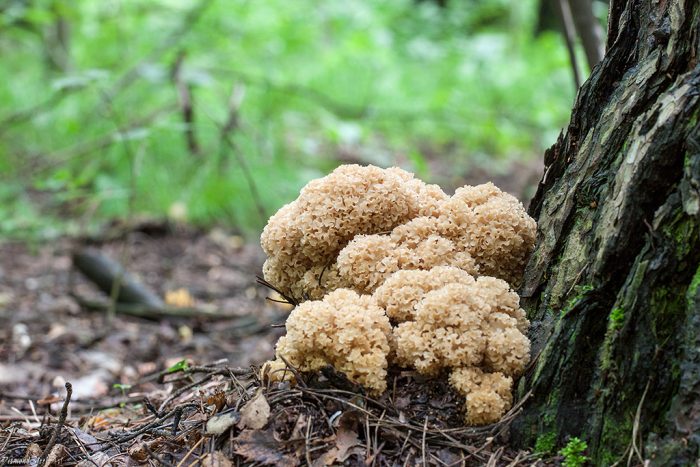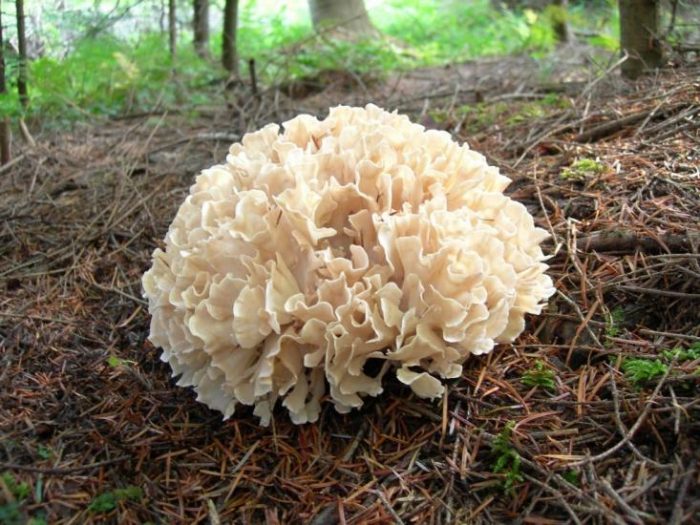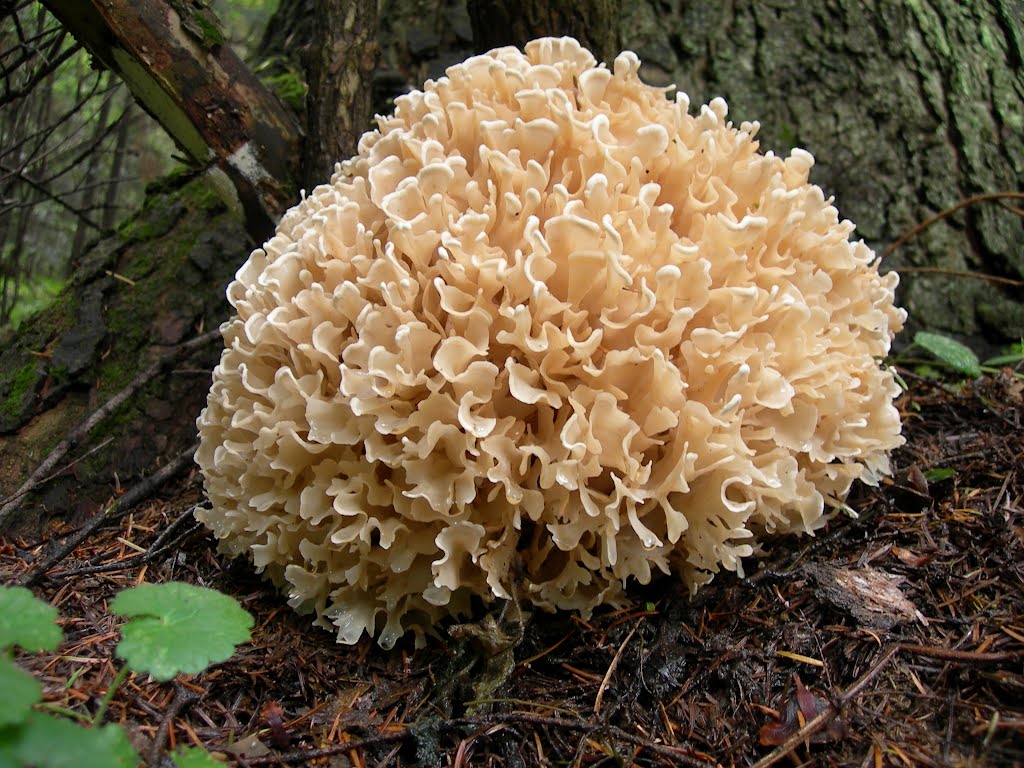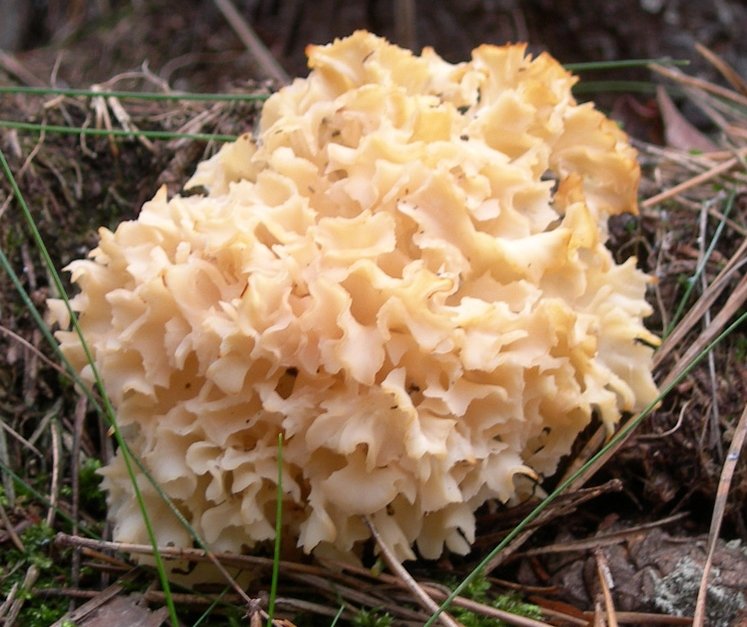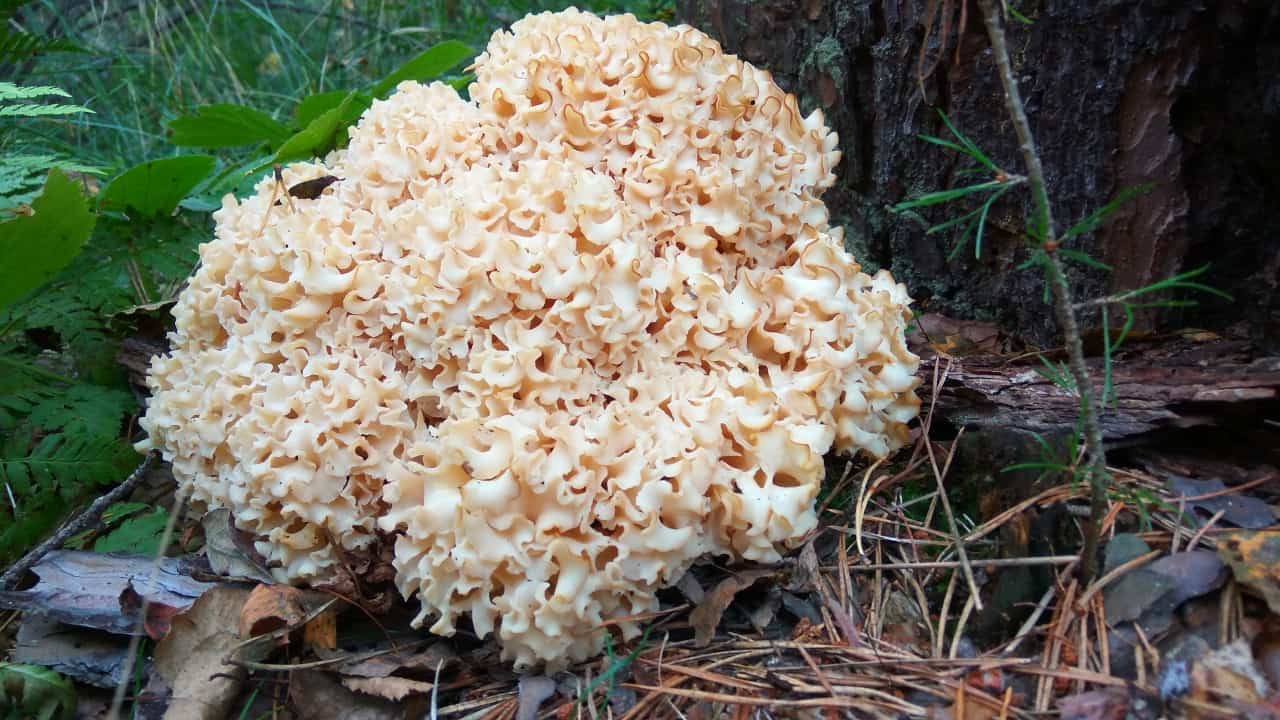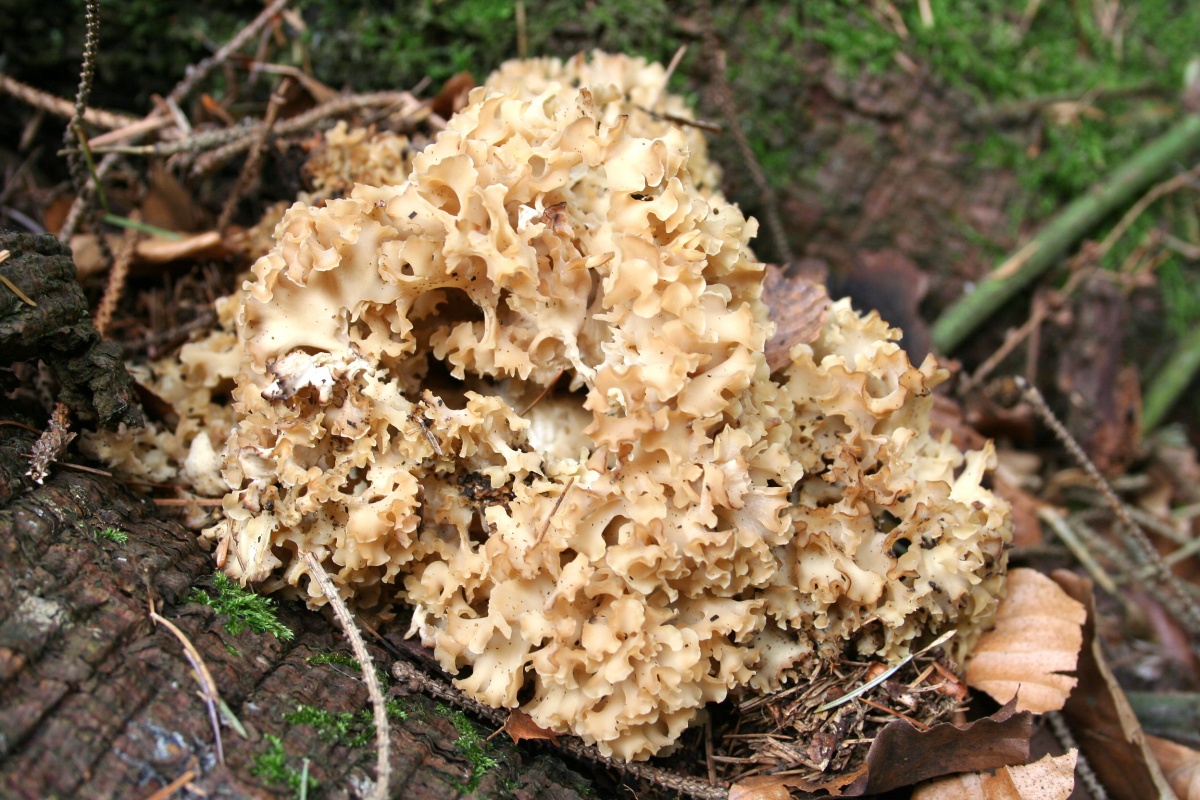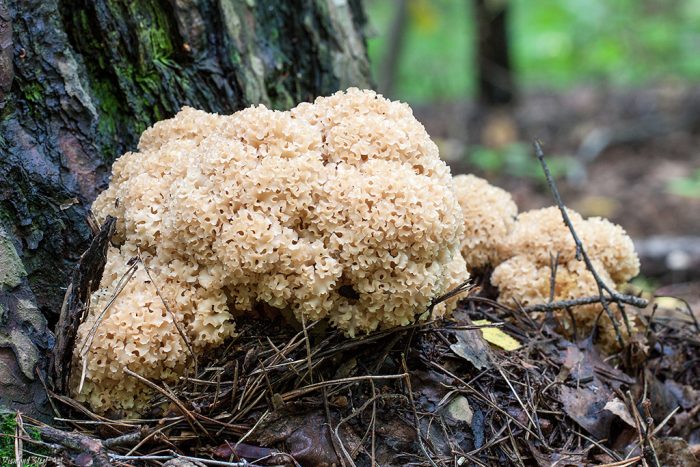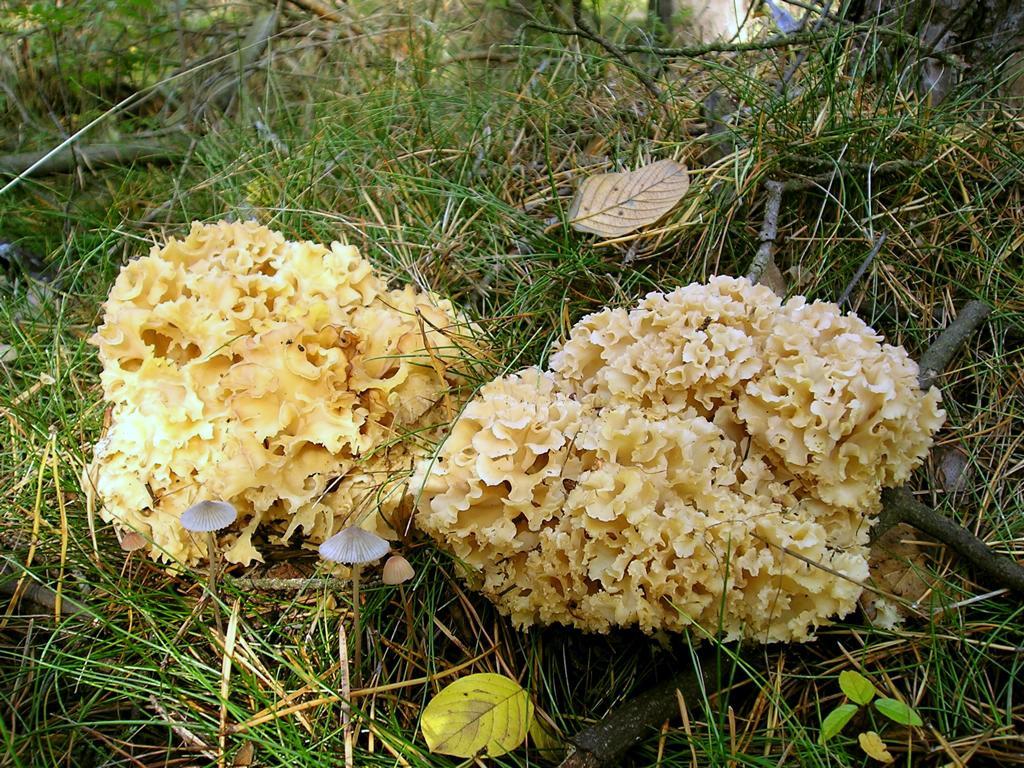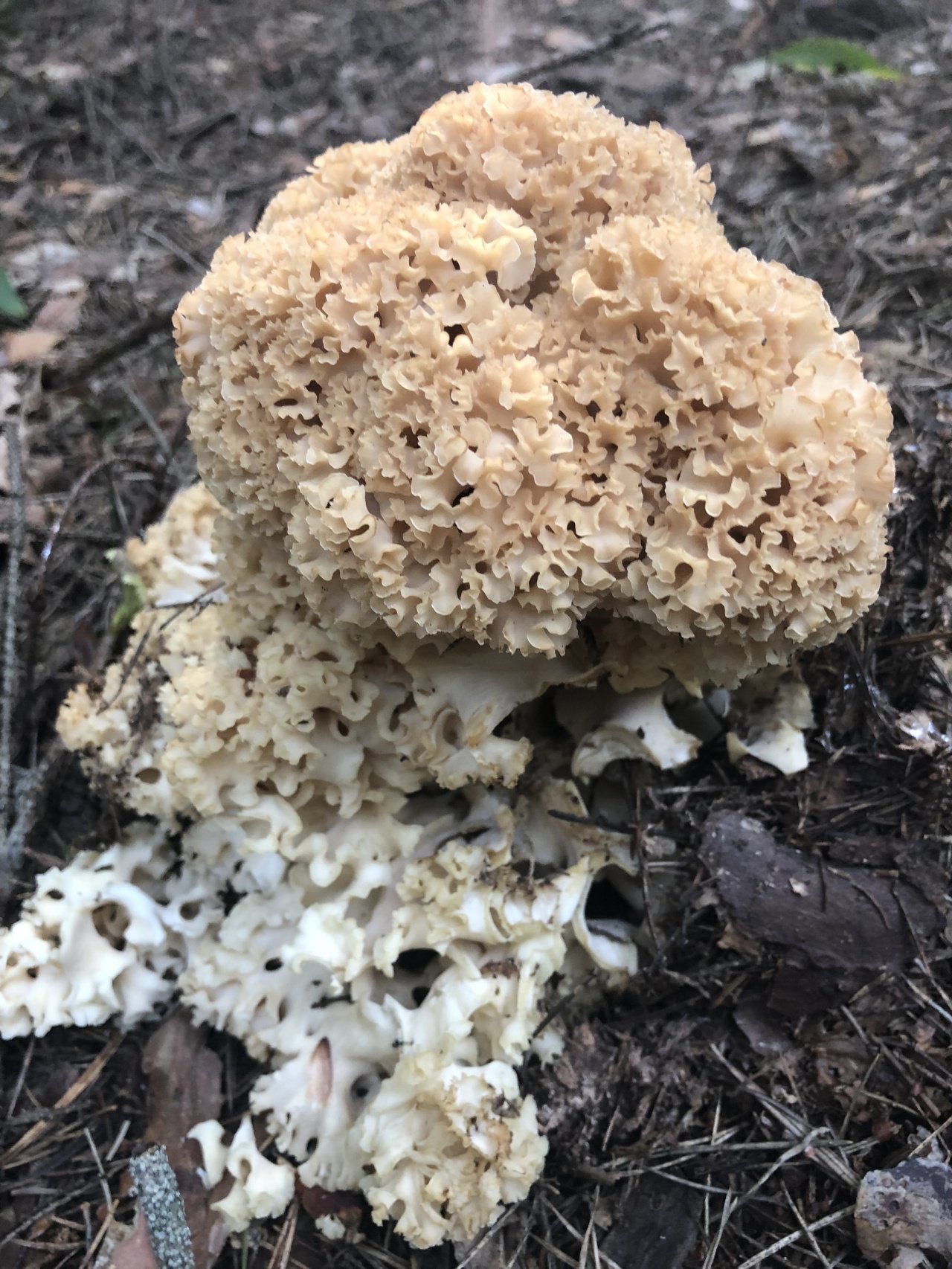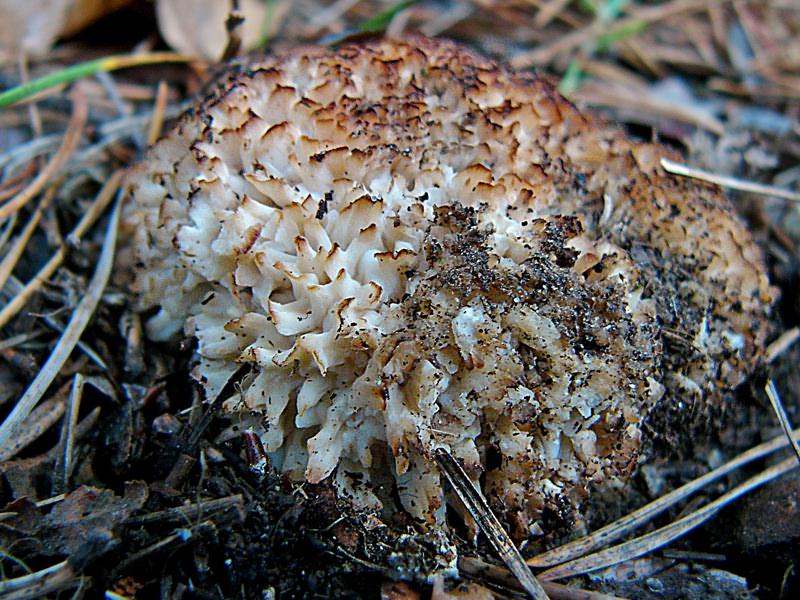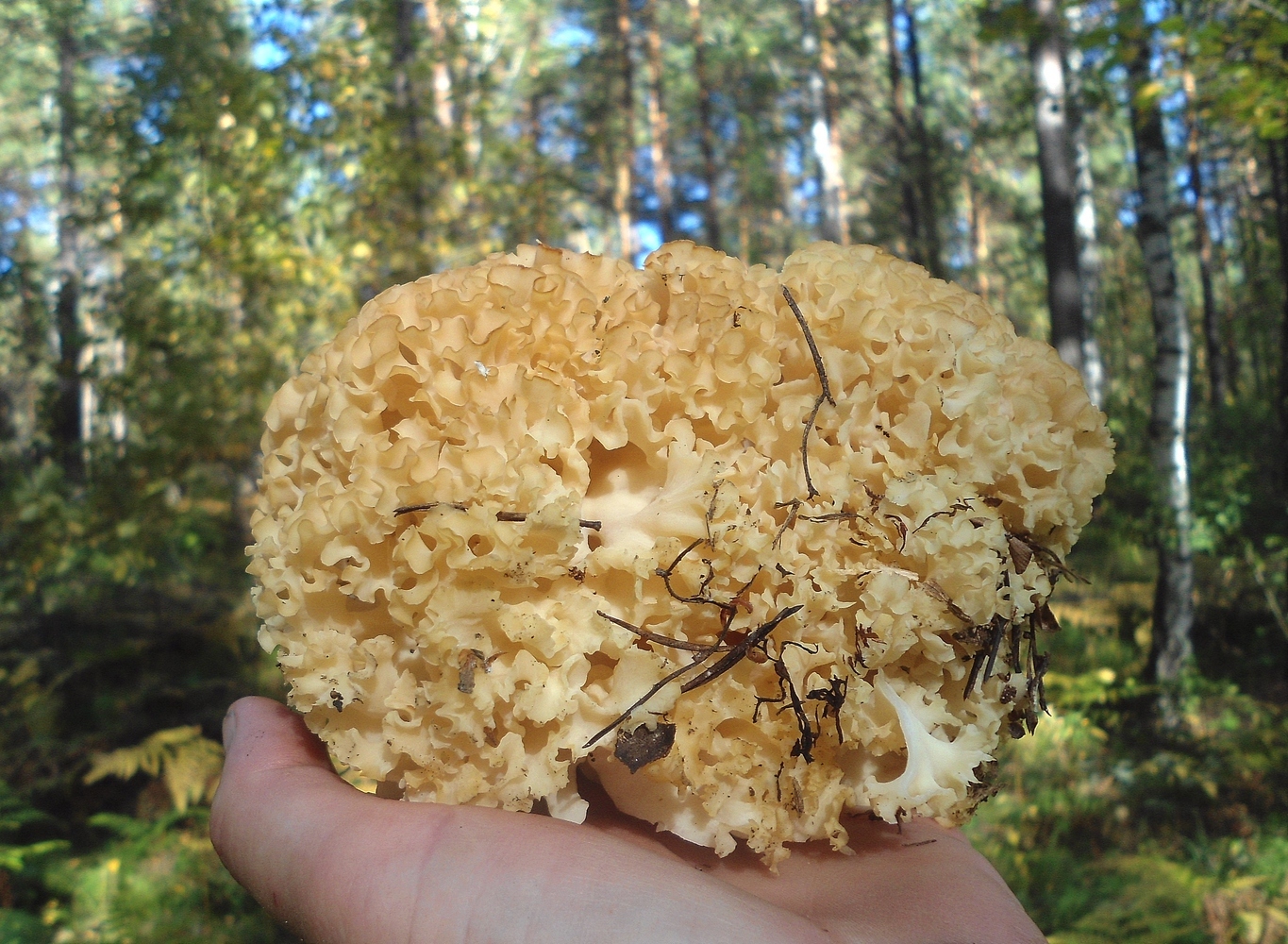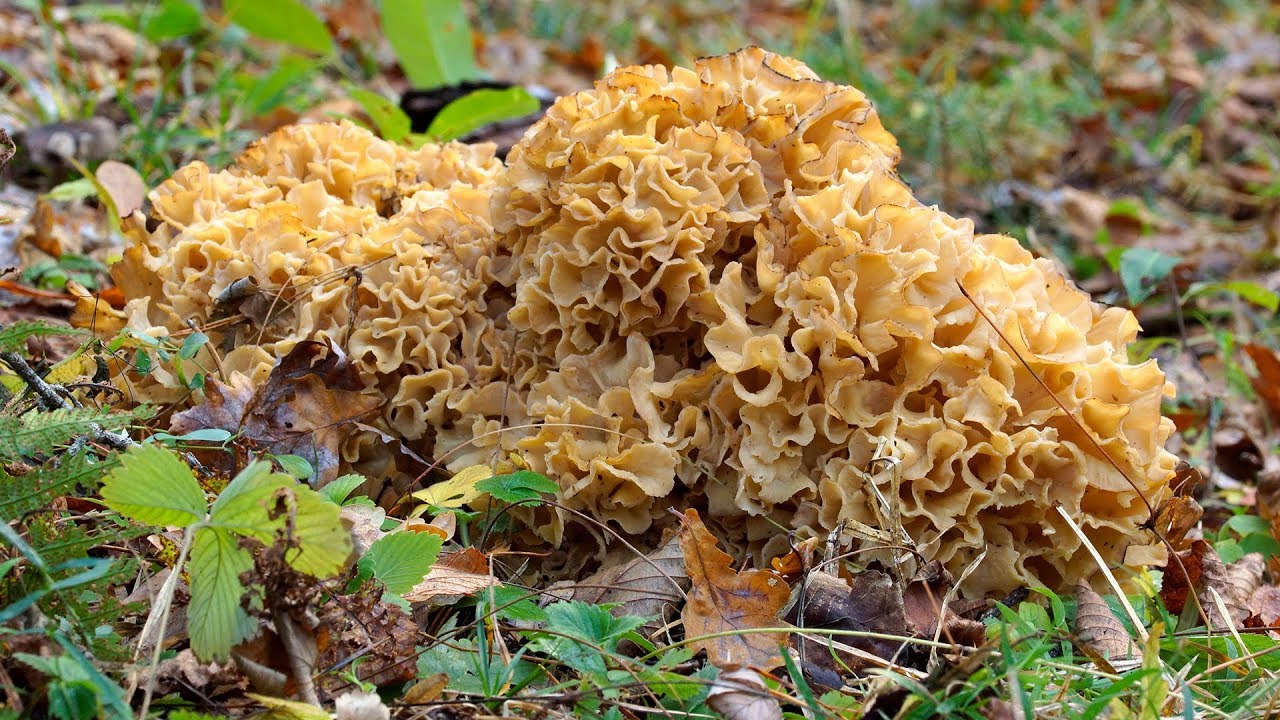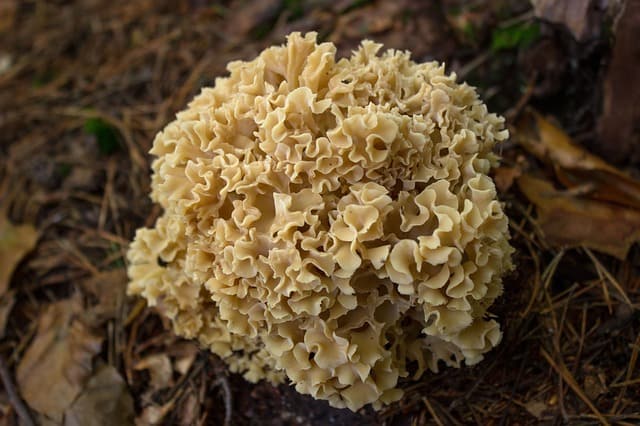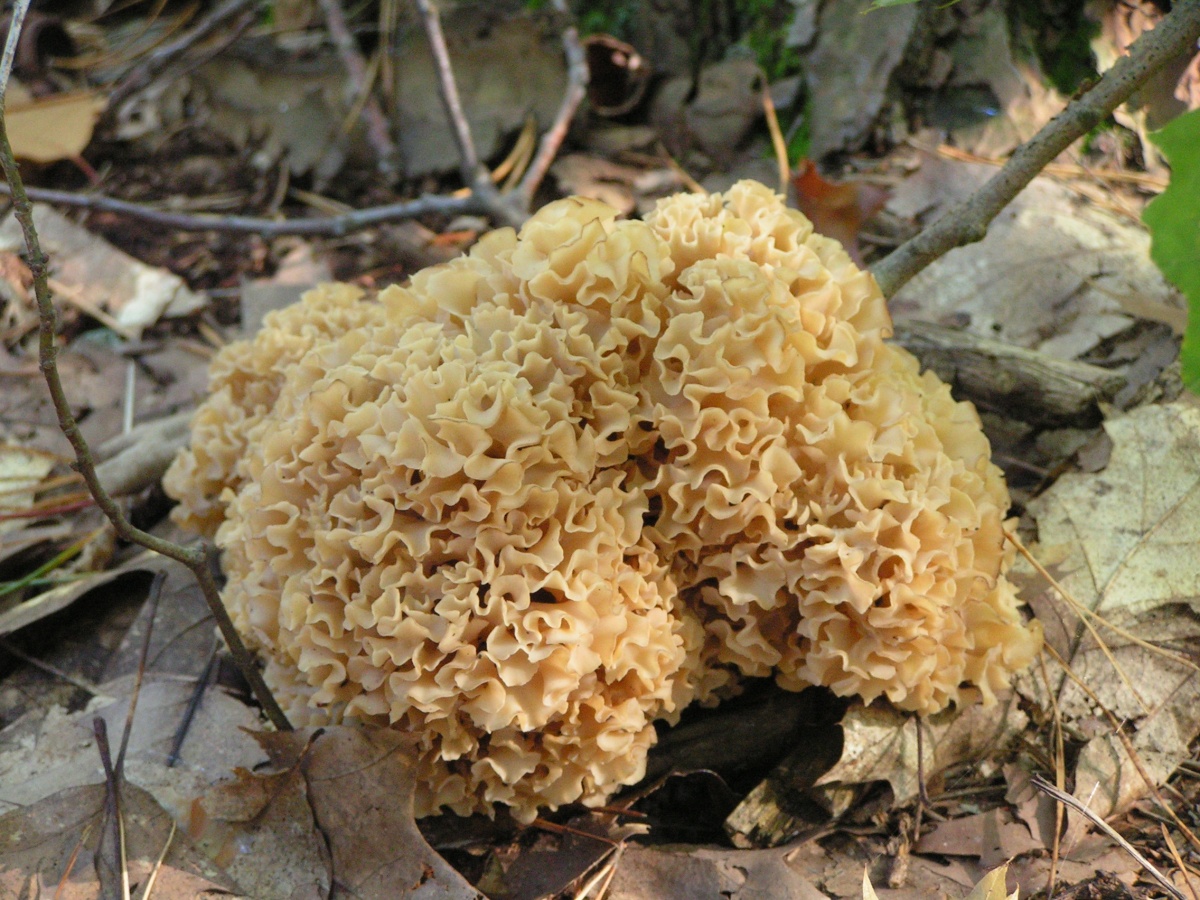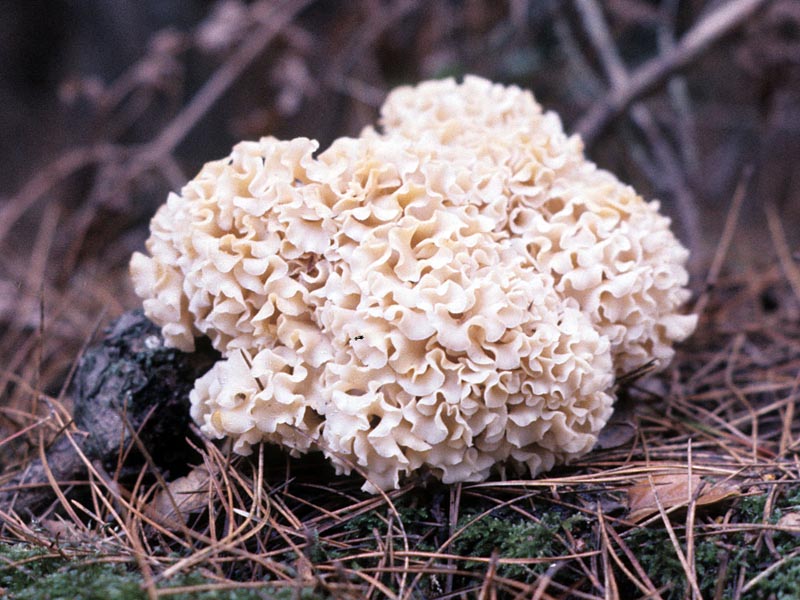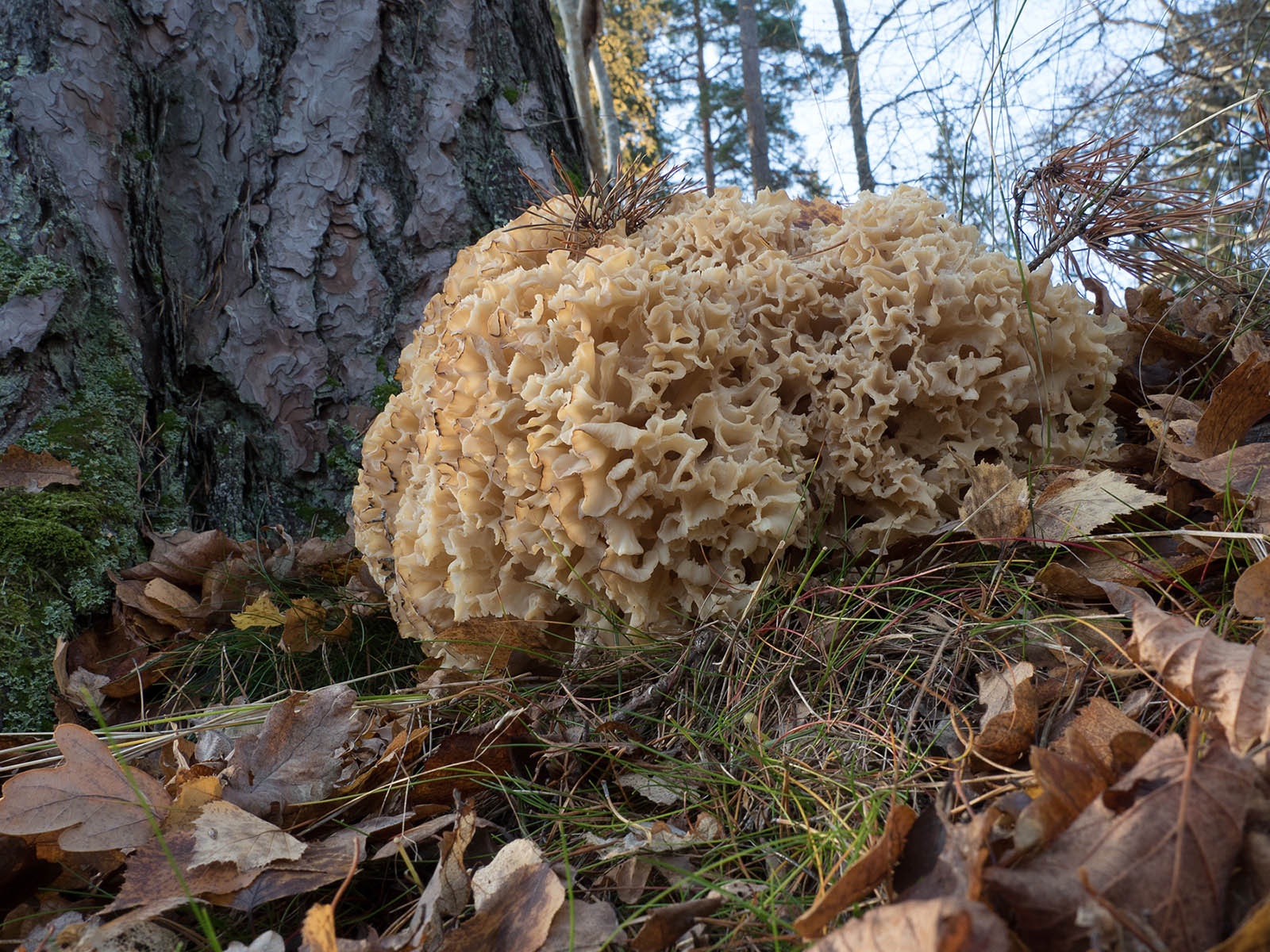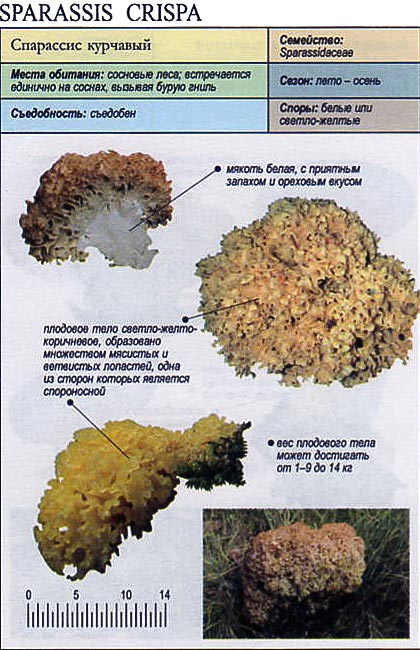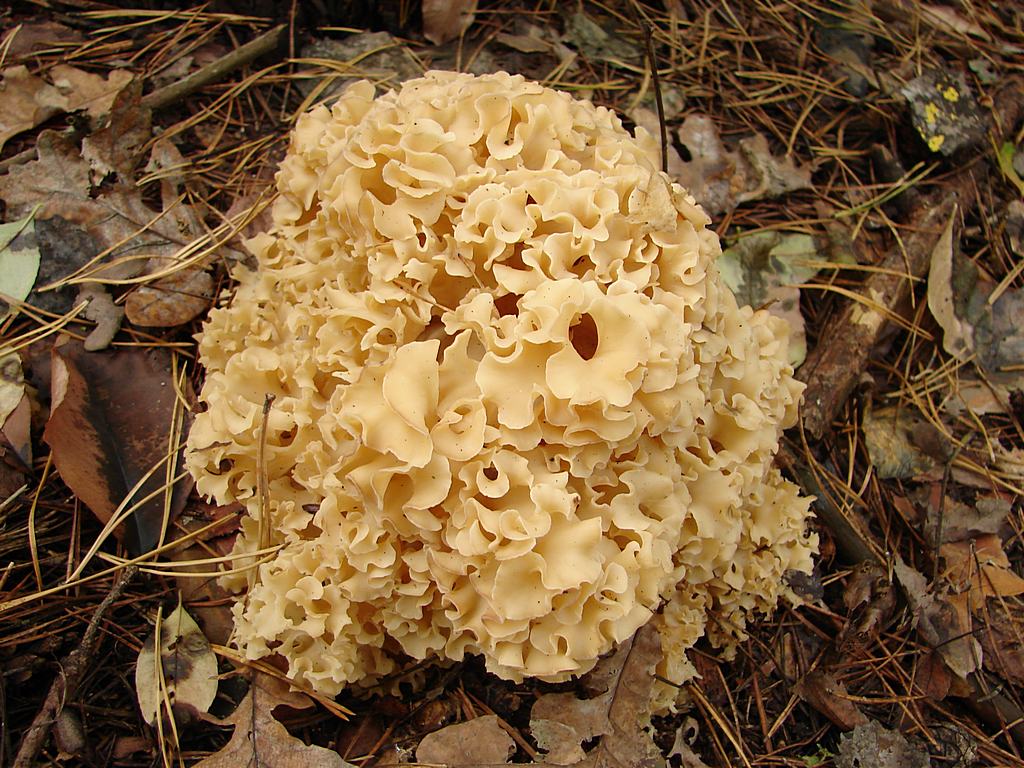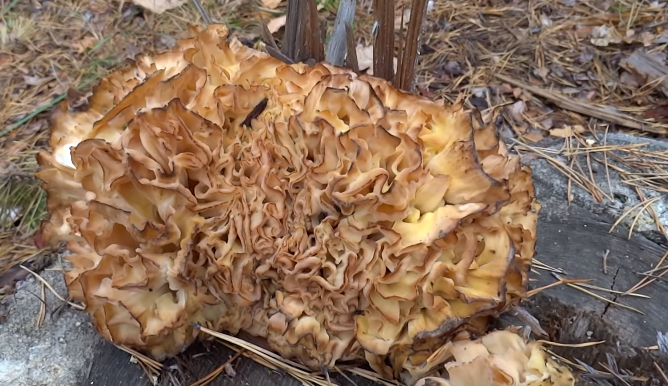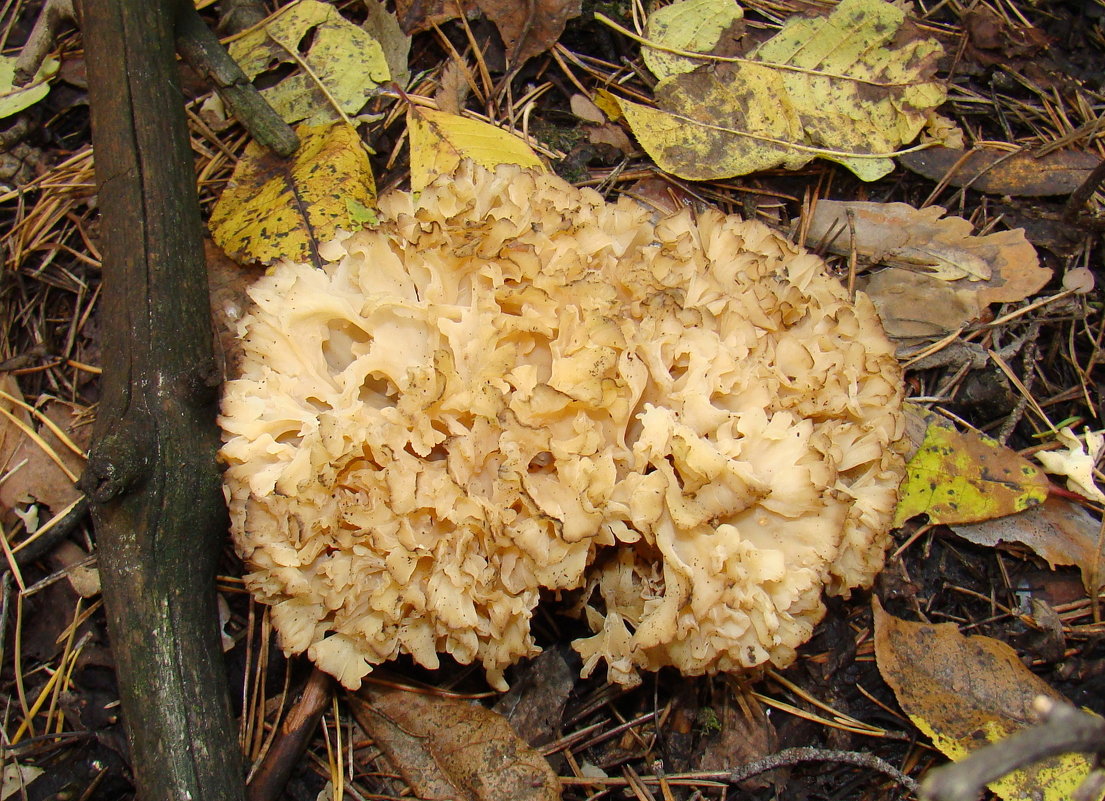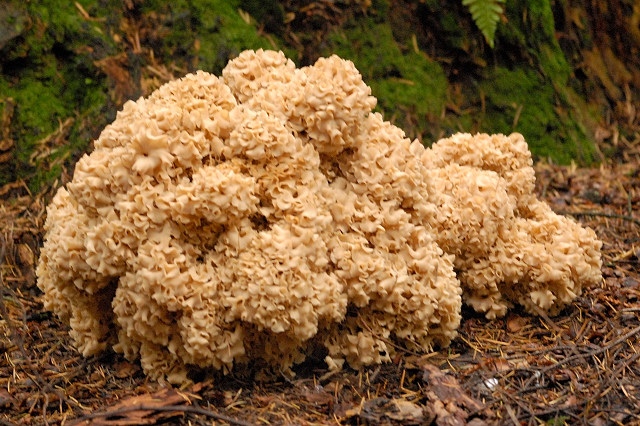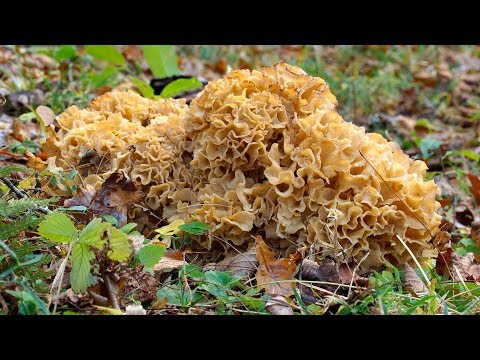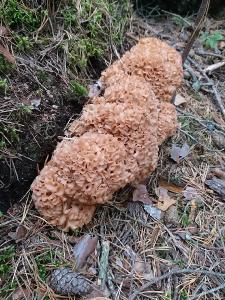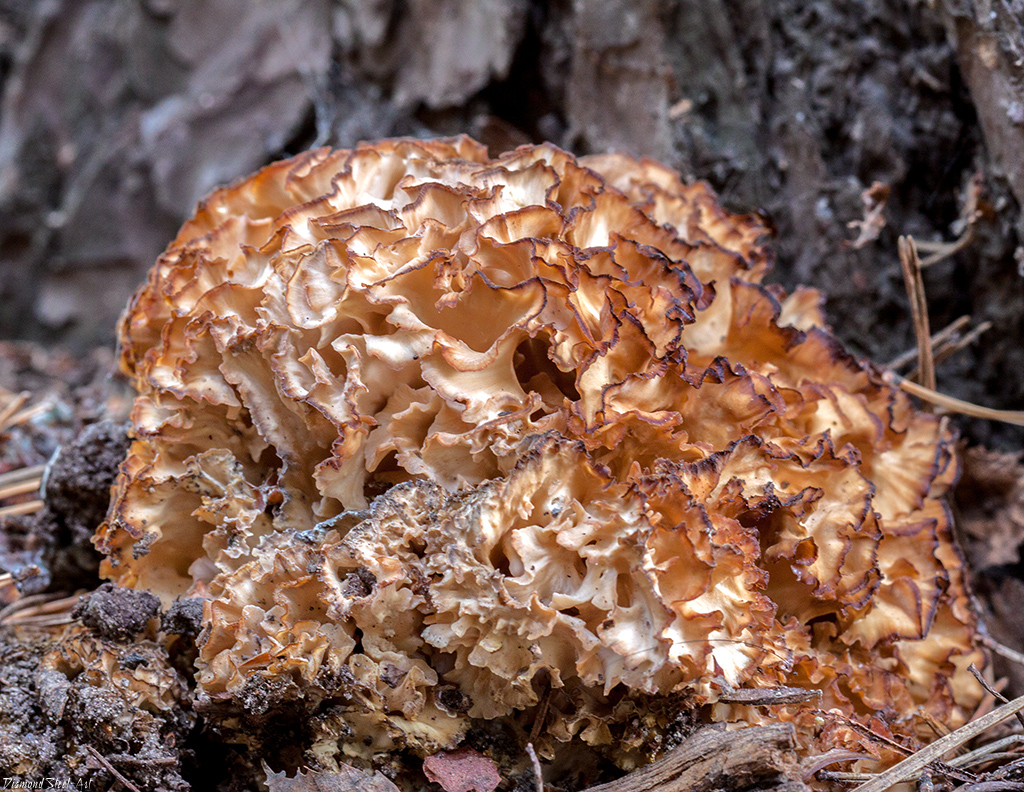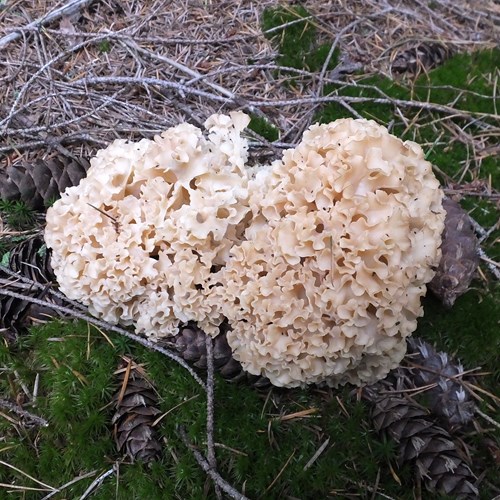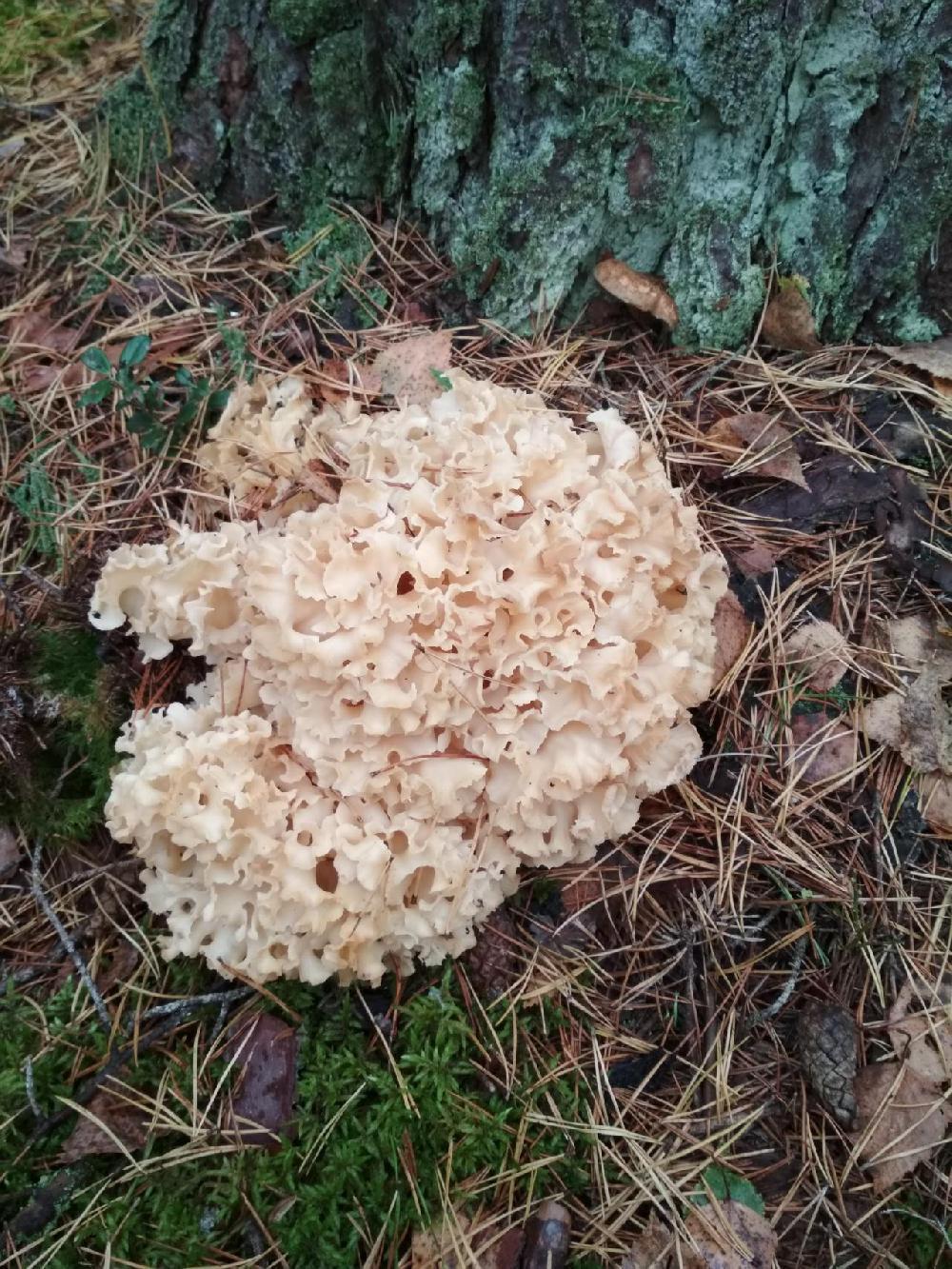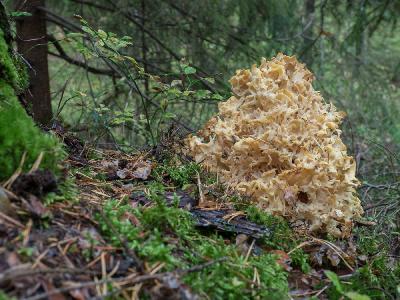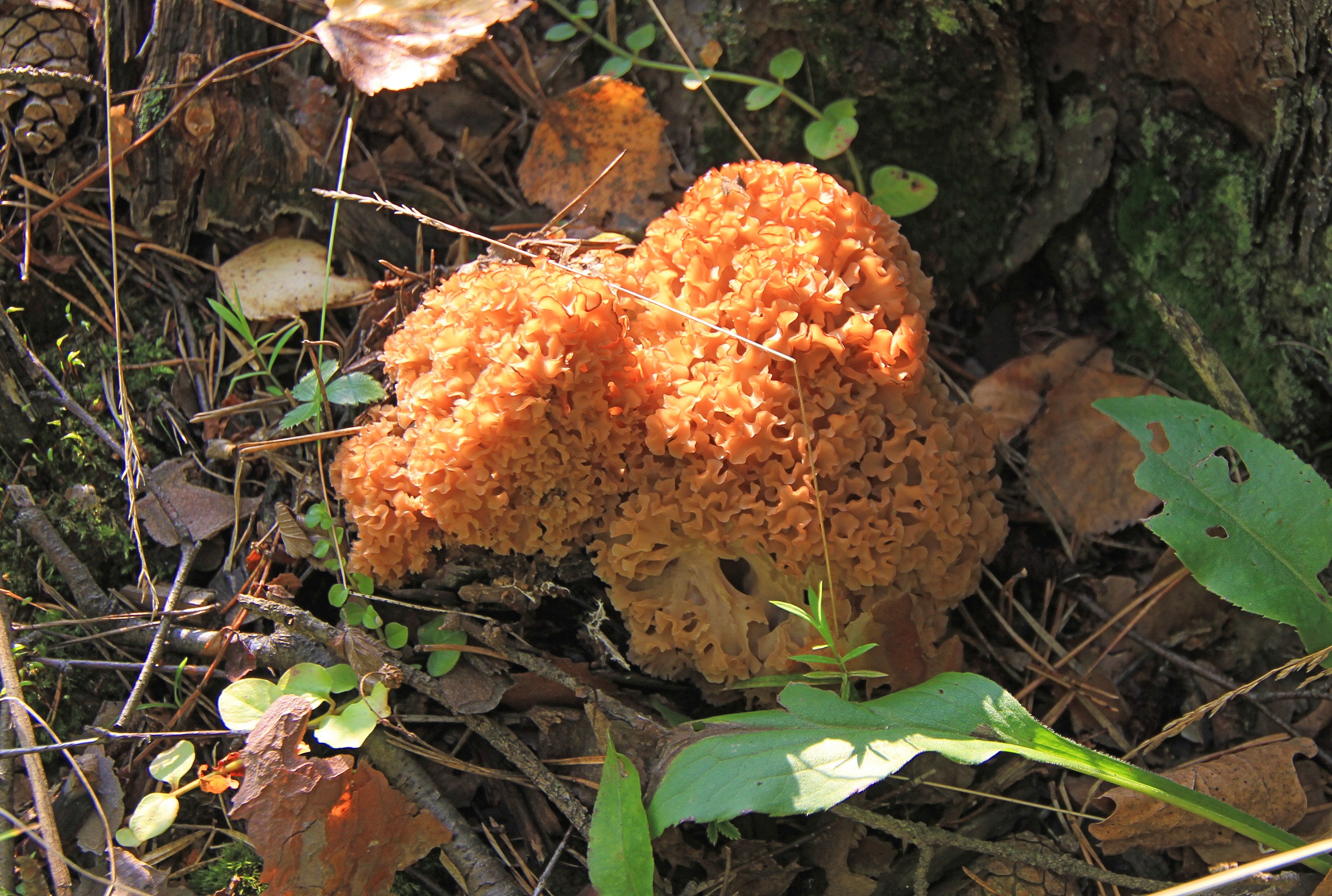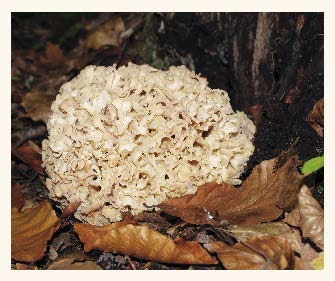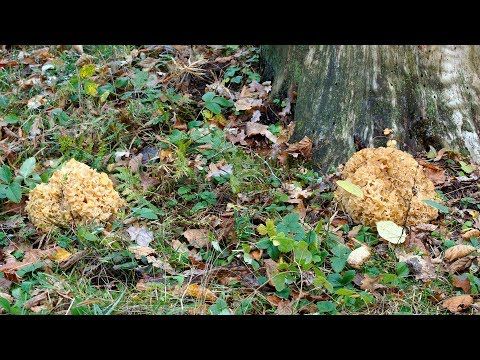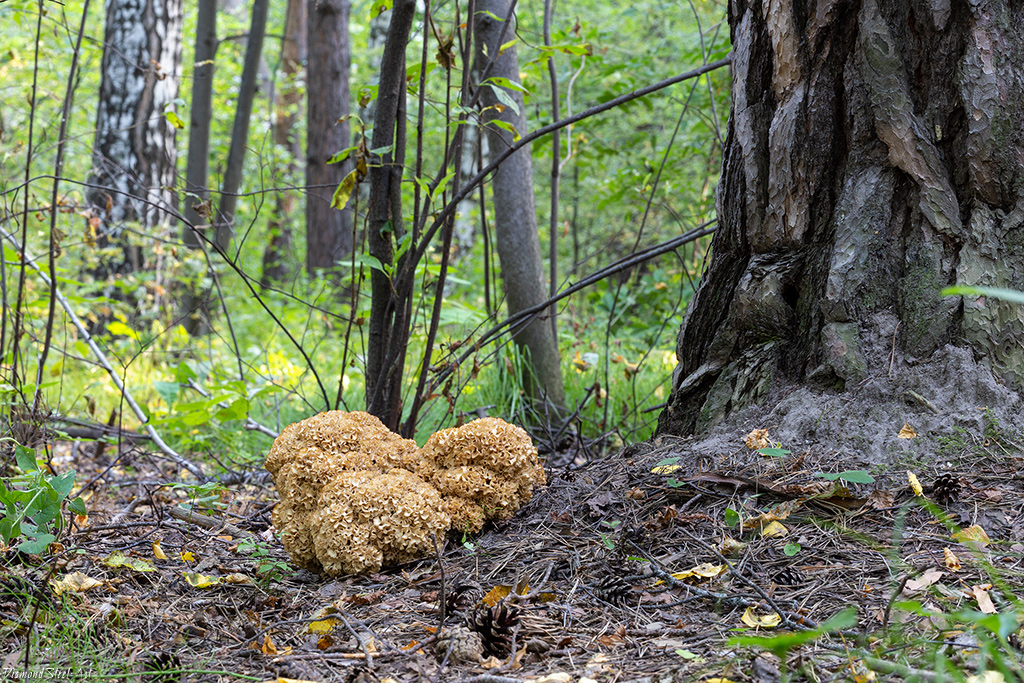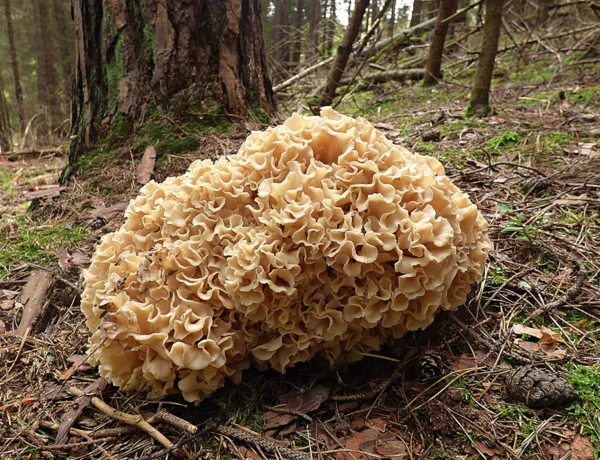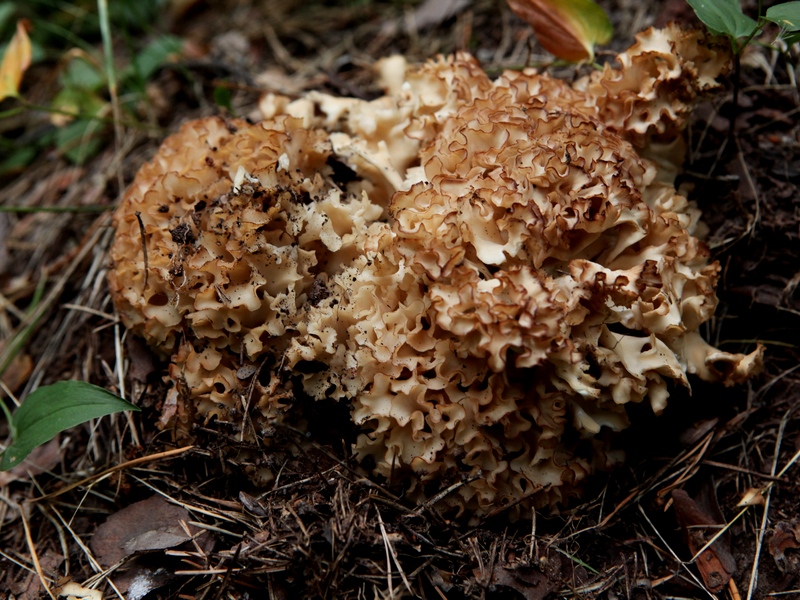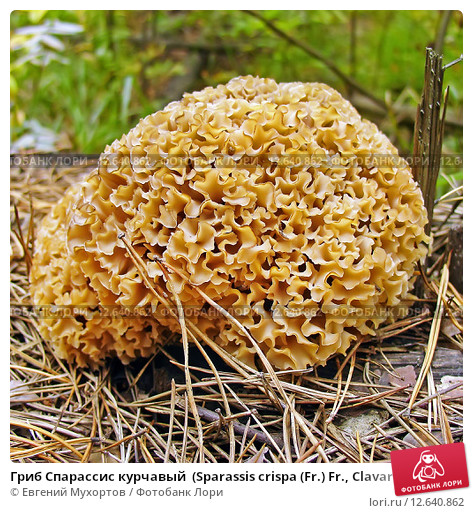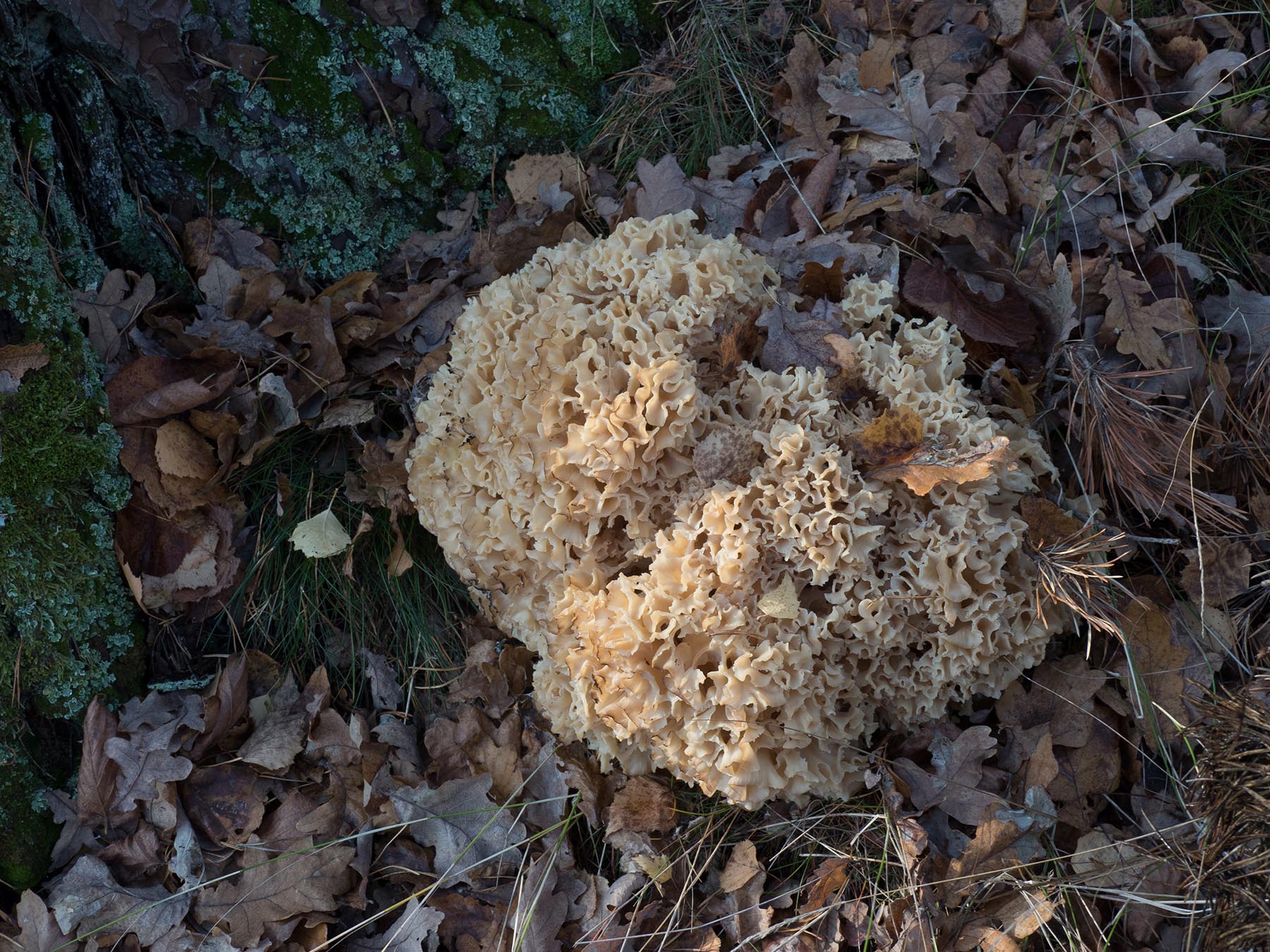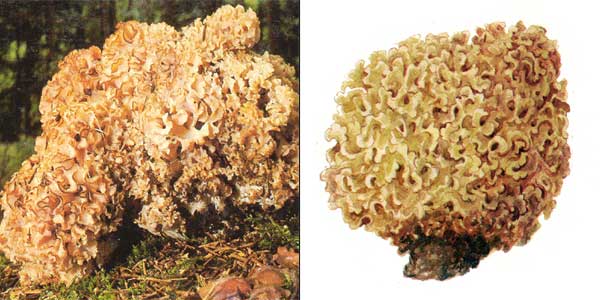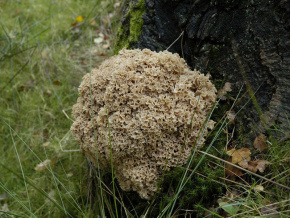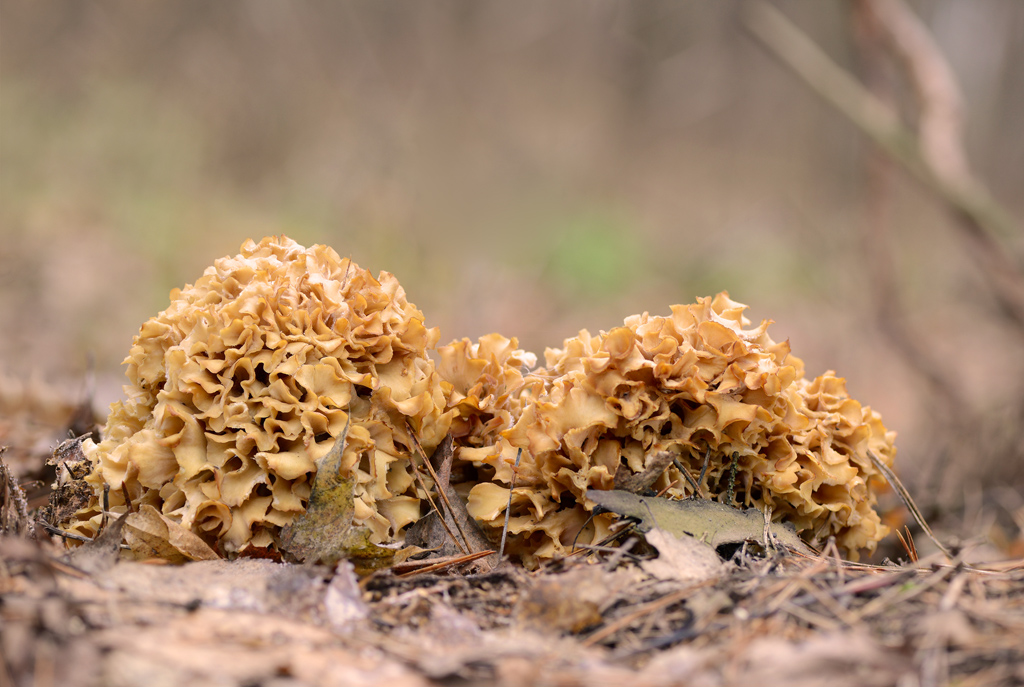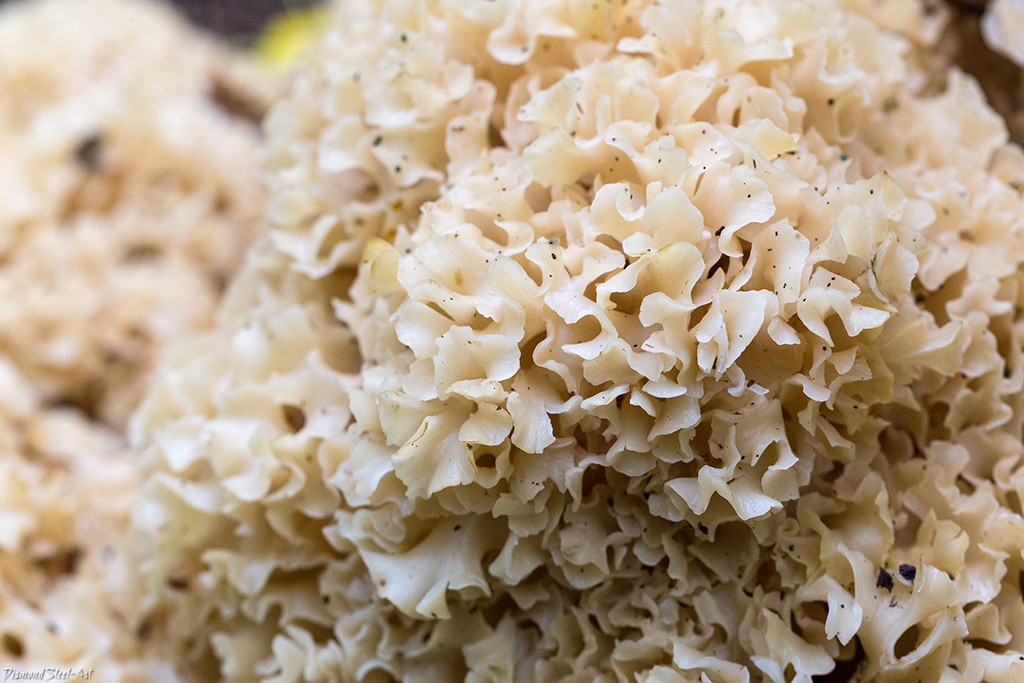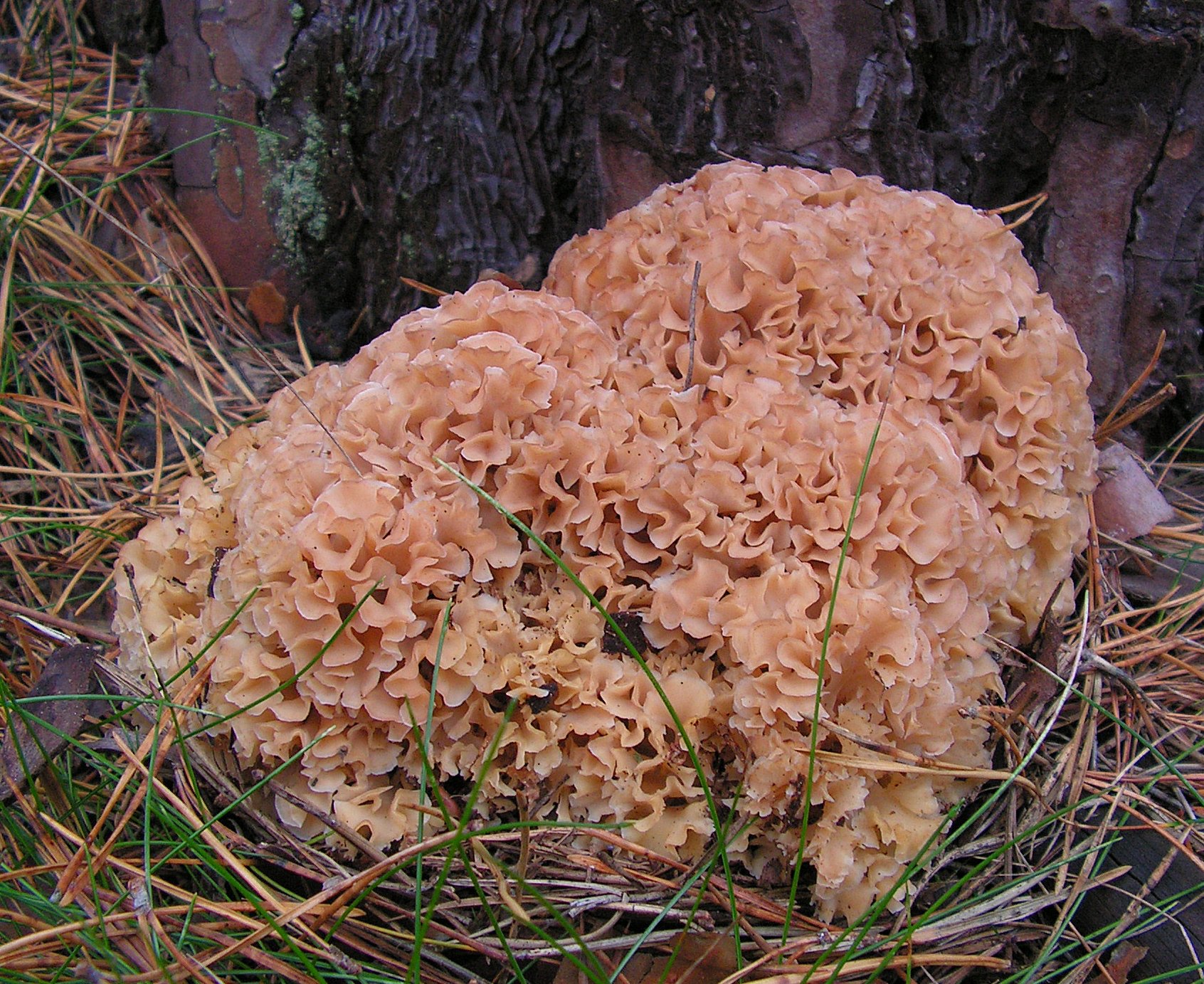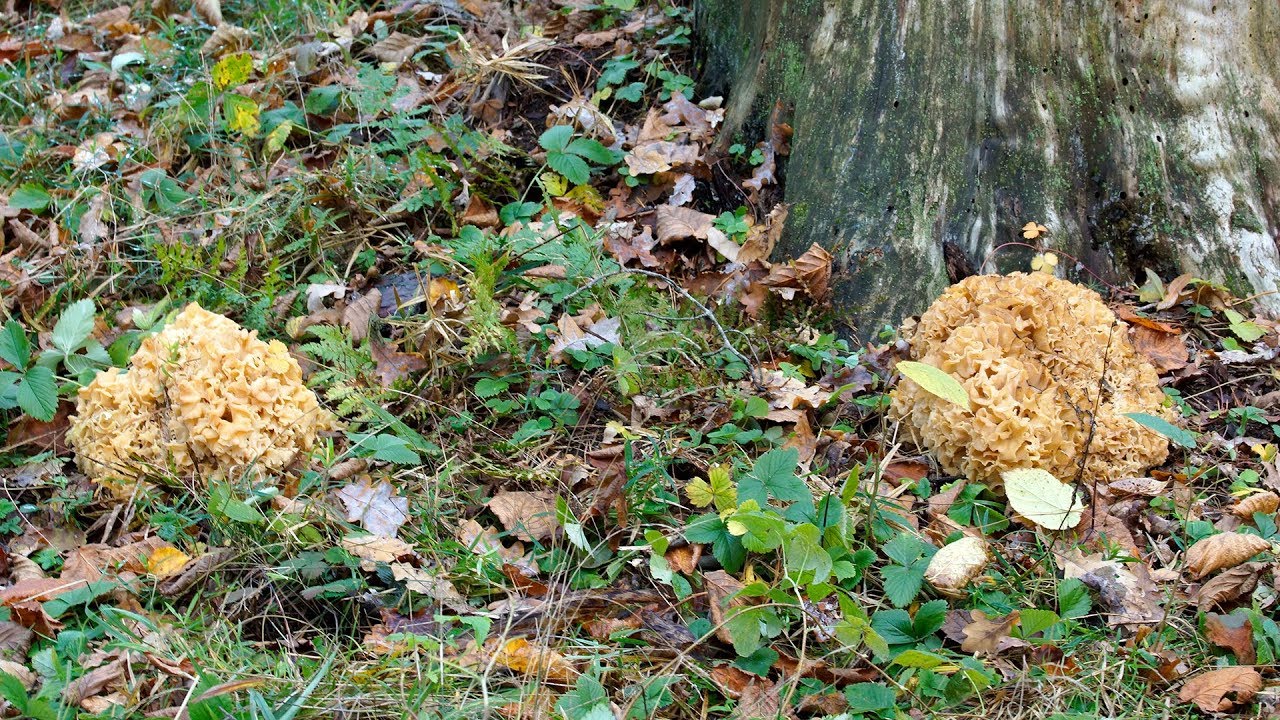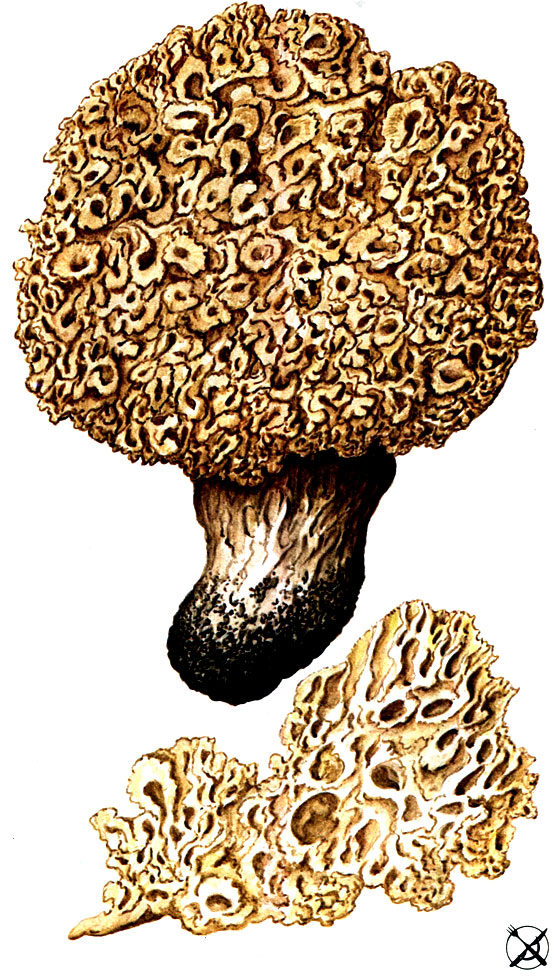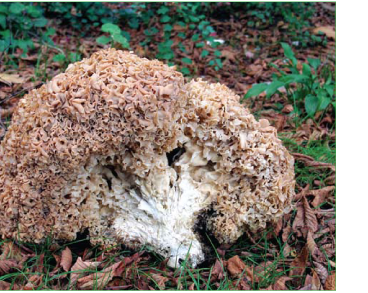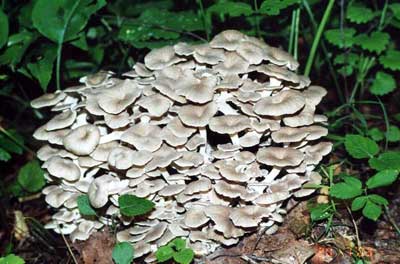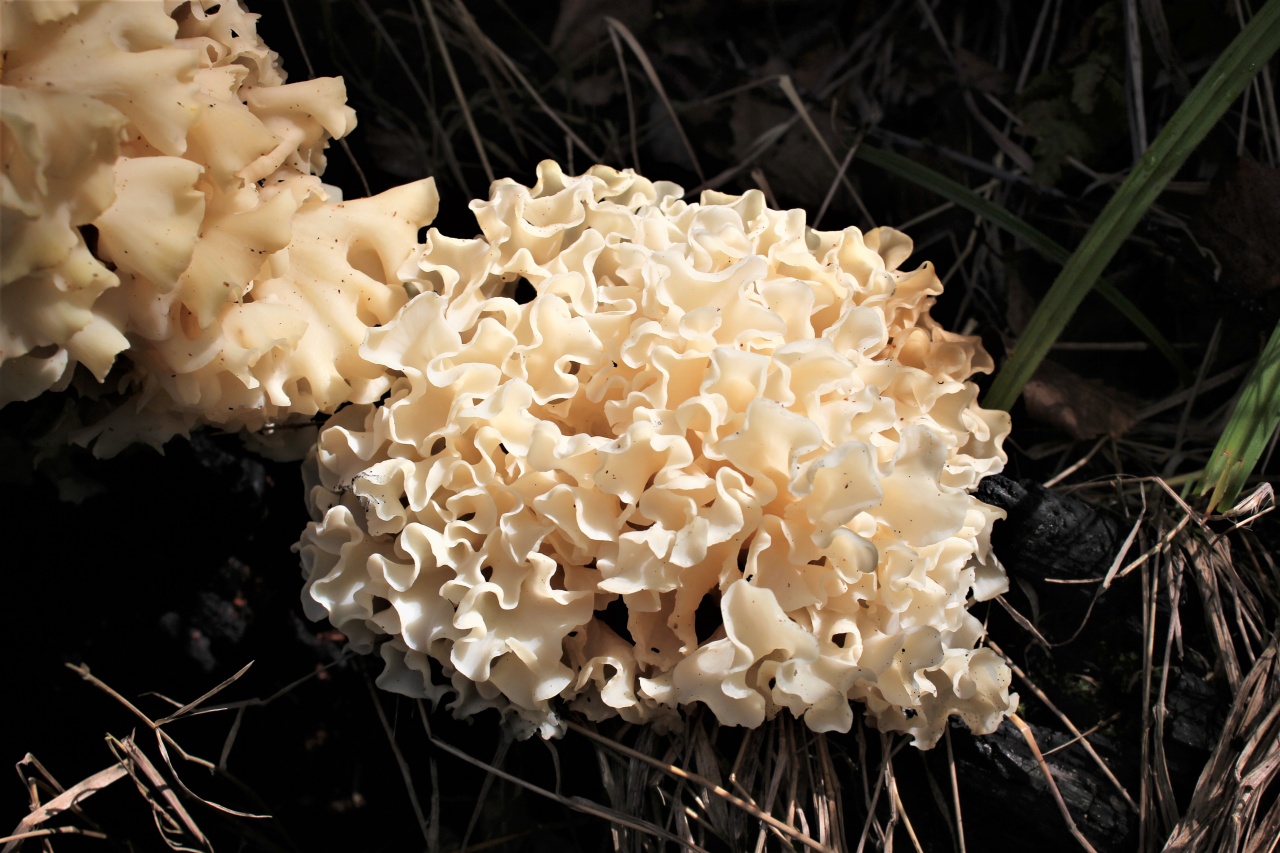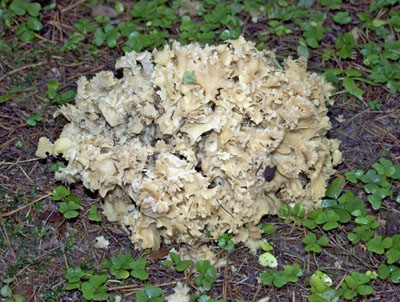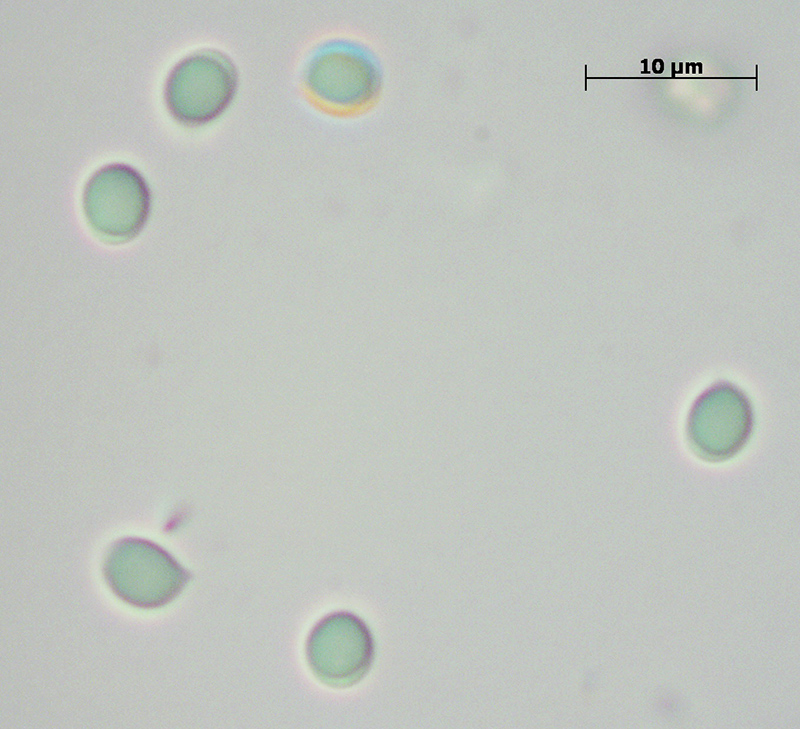Curly sparassis
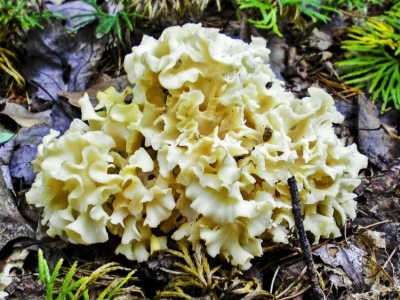
This mushroom, in its appearance, rather resembles some kind of fantasy flower or a head of cauliflower.
Curly sparassis is a very unusual and interesting organism, and besides, it is very rare - it is listed in the Red Book.
Curly sparassis (Sparassis crispa) belongs to the Sparassaceae family, which unites only 7 species. This edible mushroom, due to its unusual appearance, has several names: mushroom happiness, mushroom cabbage, ram mushroom, hare cabbage, curly dryagel, upland cabbage and king mushroom. By the way, the name "ram mushroom" in relation to sparassis is usually used only in foreign reference guides. Mycologists of Russia under this name mean one of the tinder fungus - curly griffin.
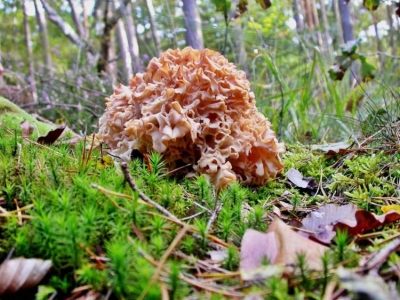
- the fruit body consists of a large number of fleshy, curly, branched blades and resembles a lush spherical bush. The dense blades are smooth or wrinkled, have a split or wavy edge. The fungus sometimes reaches quite large sizes: the diameter of the fruiting body is usually 6-35 cm, but some specimens grow to a record 60 cm.Its height is about 20 cm, and its weight often exceeds 6-8 kg: it happens that mushrooms weighing 14 kg. The color of the fruit body in young mushrooms is whitish-yellow, and in mature ones it is brown with a tinge of rust; the stem is tapered, attached to the middle of the fruiting body, thick (up to 5 cm in diameter), goes deep into the ground and therefore is hardly noticeable. Its length is about 13 cm. The color is yellowish-white, sometimes darkening with age up to black; the pulp is dense and fleshy, fragile in young specimens, similar to wax, in adults - hardening, tough. Has a nutty taste and gives off a strange odor that does not at all resemble the aroma of mushrooms; the spore-bearing layer is located on one of the sides of each lobe of the fruiting body. It has a grayish or white-cream shade, slightly rough to the touch or, conversely, smooth; spores are elliptical, from white to light yellow.
Growing at home
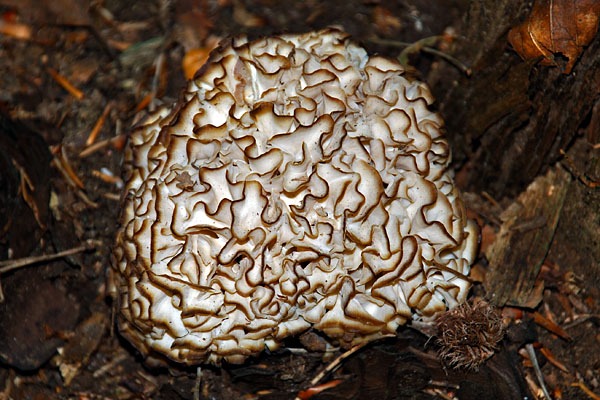
It is relatively easy to cultivate curly sparassis, like all other mushrooms that grow on wood. The technology resembles growing oyster mushrooms at home, but they use sawdust not deciduous, but coniferous trees, since curly sparassis prefers to grow on pines, spruces, cedars, firs and larch trees.
In order to prepare the nutrient substrate, very fresh sawdust is used, which should not even contain traces of chemicals that are used to treat wood in the fight against harmful insects and pathogenic microorganisms.
To improve the nutritional qualities of sawdust and obtain a finished substrate, they are mixed with hay, bran, gypsum and a small amount of a combined mineral supplement. Further, they get rid of the microorganisms present in the substrate. For this, a mixture of sawdust with additives is poured with water, brought to a boil and boiled for 1-2 hours.
After the solution cools down, the water is drained and the substrate is spread on a fine mesh, while the excess water drains from it. The moisture level of the sawdust, which is optimal, is 70%. The mixture reaches this indicator after 10-14 hours of drying on the mesh. Finished sawdust is determined by the fact that they become wet to the touch, but do not stick to the hands.
The substrate freed from excess water is applied in layers of 5 cm in a polyethylene bag, each layer is sprinkled with crushed mycelium of curly sparassis. After that, the bag is tightly tied. After a while, the mycelium will sprout and entangle the entire substrate with a dense mesh, which turns into a monolithic block. After that, holes of 2 cm by 2 cm are carefully cut out in the bag so that the fruiting bodies can later break through them.
If there is a land plot in a garden, in a greenhouse or in a vegetable garden, curly sparassis is also grown on logs of wood. The advantage of this method is that it does not require regular replacement of the substrate, since on whole wood the mycelium continues to bear fruit for several years, and not just one or two seasons, as in the previous case.
For curly sparassis, both sawdust and wood are chosen from conifers. The size of the barrel depends on the ease of use. They use both large logs about 10 m long and up to 30 cm in diameter, and small cuts 10-30 cm long. The wood must be freshly cut, or with a short period of storage. This, on the one hand, excludes the likelihood of infestation by competitive species, and on the other hand, eliminates the need for additional moisture. In addition, curly sparassis prefers fresh "feed" over dry and stale.
In the trunk at a distance of 10-15 cm, cuts are made with a drill, then the mycelium of the fungus is introduced into them and the holes are sealed with sawdust. The trunk is laid in a shady place in the garden or greenhouse. Along its entire length, it should be in contact with the soil, without sagging anywhere. In this position, the wood does not dry out, since it will be able to take moisture directly from the soil.
Curly sparassis - description, where it grows, the toxicity of the mushroom
Curly sparassis is understood in the literal sense of the word as a curly beige mushroom, which belongs to the sparass family. There are no more than 7 varieties in this family, which is remarkable. The mushroom belongs to edible and very tasty varieties, but it is listed in the Red Book of our country as an endangered type. Due to deforestation and gathering by people, the presented specimens are becoming less and less. Today we will study everything related to them.
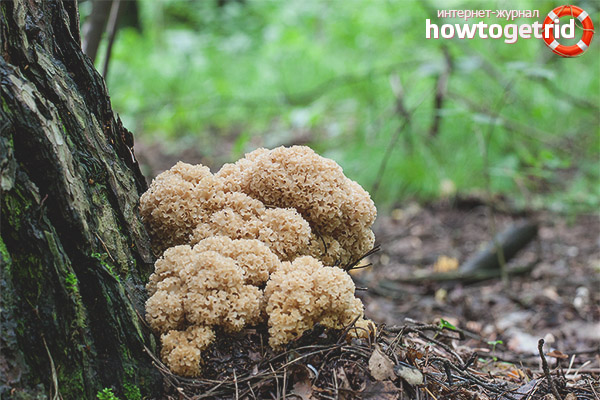
Once again, we repeat that this variety is classified as edible
The mushroom attracts attention, first of all, due to the fact that it is famous for its external data. In the common people it is called differently, including mushroom cabbage, lamb mushroom, mushroom happiness, as well as hare cabbage and mushroom king
Moreover, the name "lamb" is used only in foreign reference materials, our compatriots practically do not express themselves like that. Russian experts mean by a lamb a completely different mushroom - a curly griffin.
Now consider the description of the presented intricate instance. The fruiting body consists of multiple curly leaves that branch out and look like a shrub. The mushroom is large enough, its wrinkled blades with wavy edges cannot go unnoticed. Considering the diameter, we can say that some fruit bodies grow up to 20-60 cm. Of course, this is rare, on average there are mushrooms 7-30 cm in diameter. The bush is about 20 cm in height, and exceeds 6-8 kg in weight ... Some mushroom pickers came across specimens of 10-14 kg.
Fruit bodies are beige, yellow-white in shade. In mature specimens, the color is dark, brownish with reddish blotches. The base is poorly visible, it is tapered, attached to the center of the body. The thickness of the leg is about 5 cm, for the most part it is dug into the ground, therefore it is not visible. It grows up to 13 cm in length, is colored white-yellow, can darken and become black when overripe.
The soft part of the peculiar wavy blades is fragile, easily crumbles and breaks. In the grown fruit bodies, it is tough and hard. It tastes nutty and smells strange. The smell has nothing to do with mushroom aroma. Reproduction is carried out by elliptical spores, they are light in color with yellow or white.
The layer, which is otherwise called spore-bearing, prefers to be placed on each blade. Moreover, it occupies only one side, not completely wrapping itself around. This layer is pigmented in shade with a creamy white or gray.Feels a little rough, maybe overly smooth.
Mushroom cabbage
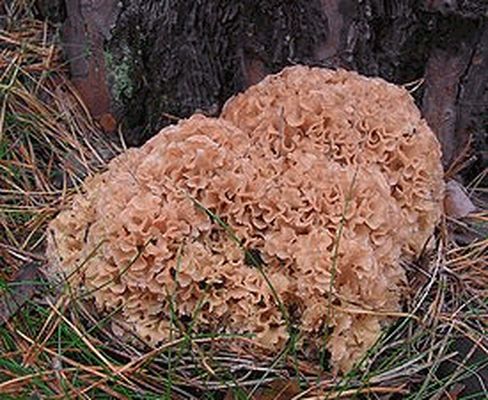
Sparassis curly, or Sparassis curly (Latin Sparassis crispa) is a type of edible mushroom from the genus Sparassis of the Sparassaceae family. A parasite (causes red rot) that grows on the roots of trees. As a rare species, it is included in the Red Book of Russia and the Red Book of the Republic of Belarus.
Other Russian names:
- mushroom cabbage, hog cabbage
- hare cabbage
- curly dryagel
- "Mushroom happiness"
- ram mushroom (this unscientific name is used mainly in translations of books by foreign authors. In domestic mycological literature, this name is applied to another species - Grifola frondosa (Fr.) S.P. Gray from the Fomitopsis family)
- mushroom king
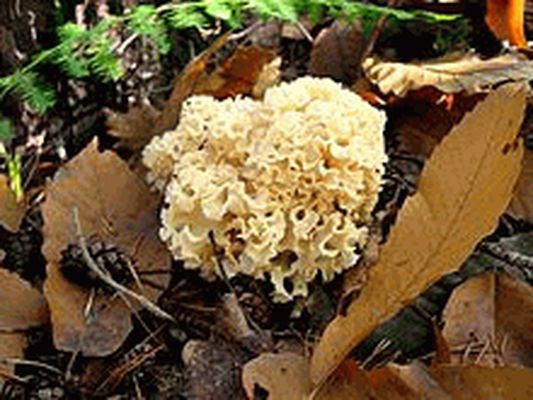
The fruiting body of the fungus is bushy, round, spherical or irregularly spherical, 5–20 cm in height and 6–30 (up to 60 and more) cm in diameter, sometimes reaching a weight of 6–10 kg. It consists of a mass of "curly" branches or lobes extending from a short central leg, with hymenium located on both sides. The blades are flat, wide (0.7-3 cm wide and 0.3-0.8 cm thick), with a wavy and often dissected edge. Outwardly, the fruiting body of the fungus resembles the head of a cauliflower. Young mushrooms are whitish, later yellowish and finally, when mature and when dry, ocher or brownish. The edges of the lobes usually darken first.
The pulp of the mushroom is white, dense, brittle in young mushrooms (over time and upon drying it takes on a hard, waxy-horny consistency), with a strong specific odor, not like mushroom. It tastes like a nut.
The hymenophore is smooth or rough, waxy, whitish-cream or grayish.
The stem of the mushroom is central, thick (2-5 cm in diameter), deeply buried in the ground, so that, despite the length (5-13 cm), it is hardly noticeable from the outside. The color of the stem in young mushrooms is whitish or yellowish, later brownish to black.
Spore powder - from whitish and yellowish to ocher and orange-ocher. Spores (6-7) × (4-5) µm, ellipsoidal, slightly narrowed at the base, smooth, colorless, with a large drop of oil.
Sometimes the fungus forms a pseudosclerotium (20–70) × (7–10) cm in size, consisting of soil particles intertwined with mycelium and attached to the roots of the tree.
Sprouting
Spreading
Occurs from August to October, sometimes from the end of July. A parasitic wood-destroying fungus, saprotrophic or weakly phytopathogenic, causing rotting of roots and wood. Grows singly on roots, at the base of trunks, less often on fresh stumps of coniferous trees (mainly pine, as well as spruce, cedar, fir, larch) in old-growth coniferous and coniferous-deciduous forests. Fruiting bodies are formed at the butt of the tree, connected by strands of mycelium with the affected root. The fungus causes a red-brown destructive rot of the roots and base of the trunk. At the final stage of development, rotten wood cracks, and mycelium clusters are observed in the cracks.
Similar species
The rarer Sparassis laminosa, which parasitizes oak, is very similar to curly sparassis. The fruit body of this mushroom is straw-yellow, and the blades are coarser, denser, whole-edged.
Outwardly similar species
Sheep mushroom (Grifola frondosa (Fr.) S.P. Gray) and branched tinder fungus (Grifola umballata (Fr.) Pil.), Growing at the base of the trunks and stumps of deciduous trees (oaks, elms, etc.). Red Book of the Russian Federation.
Use
Edible mushroom, mainly used for soups, frying and drying. However, curly sparassis is edible only at a young age - the fruit bodies, which have acquired a brownish color, become very hard. Used in folk medicine. Contains Sparassol, which inhibits the growth of molds. In addition to sparassol, curly sparassis contains bioactive components with antitumor (immunomodulatory) and antimicrobial activity.
Conservation status
Curly sparassis is listed in the Red Book of the Russian Federation with the status III (R) a rare species and in the Red Book of the Republic of Belarus. The factors limiting its number are the intensified exploitation of forests and the collection of fruit bodies by the population.
Evaluation of taste, medicinal properties, benefits and possible harm
The curly mushroom belongs to the edible class, it can form the basis of soup, mashed potatoes or pie. Hare cabbage can be dried, fried, ground into flour and sprinkled on food. Only young inflorescences and legs of mushrooms are edible. With age, they become as hard as possible, acquire a brown color and a distinct aftertaste of bitterness. But curly mushrooms stand out for their taste characteristics, in texture they are similar to morels. The smell is special, reminiscent of almonds.
Treatment
Traditional medicine has long been using the curly mushroom to treat many diseases, among which there is even oncology. This is an effective remedy against tumors, it raises the immune system, kills germs and fungi.
The benefits of hare cabbage have been proven in the treatment of even viral hepatitis. In the field of gynecology, the curly mushroom is useful for protecting against hormonal ailments. Also, this type is used in the treatment of diabetes. It actively contributes to the reduction of sugar, thanks to proteins and numerous minerals. It can be boiled, fried, dried, and it is always delicious.
Mushroom cabbage (Sparassis curly): properties
Caloric content: 30 kcal.
Energy value of the product Mushroom cabbage (Sparassis curly): Proteins: 3.7 g. Fats: 1.7 g. Carbohydrates: 1.1 g.
Mushroom cabbage or curly sparassis is an unusual-looking mushroom common in Europe, Asia and even North America. Everywhere it is a rare species, therefore it is listed in the Red Book. You can see it in August-September, it looks like a large head of cauliflower (see photo), hence the name.
It grows near trees and on stumps, and growing on the protruding roots of trees, causes a disease with their red rot, which is why curly sparassis is considered a parasite. Mushroom cabbage is initially milky white, and over time, its color becomes yellowish, darkening to brownish. The weight of such a mushroom can reach 10 kg, and its dimensions can exceed half a meter in diameter.
Description of the mushroom
Curly sparassis settles on conifers. The population size has recently decreased significantly due to the deforestation of old-growth coniferous forests. In addition, people have made efforts to make this type of fungus extinct. Now it is listed in the Red Book of Russia, Belarus, Ukraine.
The fungus is rarely found in our forests, especially the larger specimens. It appears from the second half of the summer season, you can meet it until mid-autumn. The above-ground body can gain in diameter from 10 cm to 60 cm. Sometimes fruit bodies weighing 6-10 kg are found.
According to the species description, curly sparassis has a rounded elongated shape, it looks like a branched coral or a branched tree. Consists of flat twigs-plates. They have a wavy scalloped edge. Young mushrooms are white, creamy. It gets darker with age.
For your information. If in a deciduous forest on an oak they met a mushroom similar to curly sparassis - you are very lucky, because you were able to get acquainted with the closest relative of this species - lamellar sparassis.
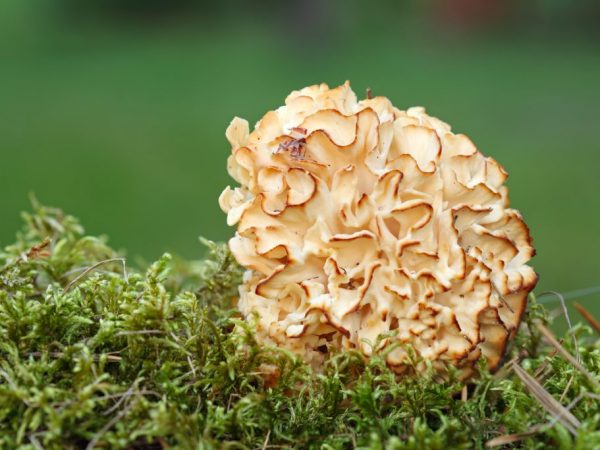
Sparassis curly settles on conifers
The consistency of the pulp in the plates also gives away the age of the specimen. In young people, it is soft, tender, the taste is nutty and pleasant. Over time, it becomes tougher, and it can no longer be used as food.
Mushroom properties
Curly Sparassis contains a large amount of beta-glucan polysaccharide, more than 40% dry weight. This substance has a striking immunomodulatory property and is widely used in pharmacology in all countries of the world.It is a strong antioxidant, counteracts the development of tumor, inflammatory and allergic processes.
Sparassis curly contains sparassol - a compound that prevents the development of molds, protects against pests and various diseases. It also benefits people, as it has antimicrobial and antimycotic activity.
The components of curly sparassis have the following medicinal properties:
- antineoplastic;
- antioxidant;
- immunomodulatory;
- antibacterial;
- antifungal.
The fungus helps allergy sufferers, hypertensive patients and people who have suffered post-stroke conditions, as well as those suffering from diabetes.
Traditional medicine is known for the effectiveness of sparassis curly in the fight against malignant tumors, especially melanoma and sarcoma. It is also used in the treatment of hormonal disorders, obesity.
By the way. In the countries of Southeast Asia, sprassis has long been widely used in pharmacology.
How to cook?
How to cook mushroom cabbage? In cooking, for the manufacture of various dishes, curly sparassis is boiled, baked and stewed along with other products, fried, dried, pickled and salted (some cooks do not recommend using the last two methods of preparation for this product). But all the recipes for making mushroom cabbage say that you need to use only a young mushroom of a light color. If the curly sparassis has a brown tint, then the pulp will be tough and undercooked.
You can cook mushroom cabbage both in a regular saucepan and in special kitchen appliances (multicooker and double boiler). Let's consider each cooking method in more detail.
To cook curly sparassis in a saucepan, you need a couple of these mushrooms, which should first be soaked in cold water for a quarter of an hour to make them easier to clean. After fifteen minutes, clean the mushroom cabbage of dust and dirt, and then rinse again under running water. Next, the mushrooms must be divided into smaller pieces, put into a container, completely filled with water, add salt to taste and put on the stove. When the broth boils in a saucepan, reduce the heat to a minimum, remove the foam that appears and boil the pieces of mushroom cabbage for about twenty minutes. After that, the boiled curly sparassis should be laid out in a colander so that the remaining liquid is drained from it.
How to cook mushroom cabbage in a slow cooker? First, you need to put the peeled and chopped mushrooms into a special steamer, and pour water into the container for the device. Then put the steamer with mushroom cabbage on top of the multicooker container, close the lid and turn on the "Steam cooking" program, setting the timer for half an hour. At the end of this program, pour out the liquid from the container of the electrical appliance and transfer the pieces of curly sparassis there, adding salt at your discretion. Select the "Extinguishing" program for twenty minutes. By the way, you shouldn't add water to mushrooms, as they will languish in their own juice. When the mushrooms are slightly stewed, switch the "Stew" program to "Baking", setting the timer for ten minutes so that the remaining moisture will come out of the mushrooms.
Cooking mushroom cabbage in a double boiler does not take much time and labor. Pour water into a special tray of a household appliance, install a container on top, putting pieces of washed and peeled curly sparassis there. Close the steamer and set the timer for thirty minutes.
When boiling mushroom cabbage, you should not add various spices to the broth, because this can spoil the specific aroma of the mushrooms and their nutty flavor. It is also worth sticking to the specified time. If you digest curly sparassis, it will fall apart and lose its taste.
To taste the fried mushrooms, you need to peel the mushroom cabbage, wash and disassemble it into small inflorescences, or just cut it.Next, put a little butter on a preheated frying pan and, when it melts, put the inflorescences of curly sparassis. Fry the mushrooms over medium heat for about twenty minutes, stirring regularly.
Dry mushroom cabbage in the same way as other types of mushrooms. But only first you need to divide the curly sparassis into inflorescences, then cut, and then spread out on a baking sheet covered with parchment paper. It is necessary to dry such a mushroom in an oven with a slightly open door at a temperature of no more than seventy degrees for five hours. If the house has a special electric dryer, the drying time will take about three hours. If, after drying, a powder is made from the mushroom pieces, it means that the inflorescences of mushroom cabbage should first be soaked in water, then dried, then put on a baking sheet and dried in the oven for about three hours at a temperature of forty degrees. After that, increase the temperature regime to sixty degrees and dry for no more than four hours.
To make mushroom powder from dried sparassis curly, you need to grind pieces of dried mushroom cabbage in a blender to a powdery state, adding salt to taste and a little clove with cinnamon. You need to store such a spice in a glass container with an airtight twist.
Description of the mushroom curly sparassis, places of its distribution
A very rare and tasty edible mushroom - curly sparassis, it is listed in the Red Book. Where does it grow, at what time does it bear fruit? Description, use, similar types. This mushroom, in its appearance, rather resembles some kind of fantasy flower or a head of cauliflower. Curly sparassis is a very unusual and interesting organism, and besides, it is very rare - it is listed in the Red Book. But where can you find this curly miracle of nature? Let's get to know him better.
Curly sparassis (Sparassis crispa) belongs to the Sparassaceae family, which unites only 7 species. This edible mushroom, due to its unusual appearance, has several names: mushroom happiness, mushroom cabbage, ram mushroom, hare cabbage, curly dryagel, upland cabbage and king mushroom. By the way, the name "ram mushroom" in relation to sparassis is usually used only in foreign reference guides. Mycologists of Russia under this name mean one of the tinder fungus - curly griffin.
- the fruit body consists of a large number of fleshy, curly, branched blades and resembles a lush spherical bush. The dense blades are smooth or wrinkled, have a split or wavy edge. The fungus sometimes reaches quite large sizes: the diameter of the fruiting body is usually 6-35 cm, but some specimens grow to a record 60 cm.Its height is about 20 cm, and its weight often exceeds 6-8 kg: it happens that mushrooms weighing 14 kg. The color of the fruit body in young mushrooms is whitish-yellow, and in mature ones it is brown with a tinge of rust,
- the stem is tapered, attached to the middle of the fruiting body, thick (up to 5 cm in diameter), goes deep into the ground and therefore is hardly noticeable. Its length is about 13 cm.The color is yellowish-white, sometimes darkens with age, up to black,
- the pulp is dense and fleshy, fragile in young specimens, similar to wax, in adults - hardening, tough. Has a nutty taste and gives off a strange odor that does not at all resemble the aroma of mushrooms,
- the spore-bearing layer is located on one of the sides of each lobe of the fruiting body. It has a grayish or white-cream shade, slightly rough to the touch or, conversely, smooth,
- spores are elliptical, from white to light yellow.
Distribution and fruiting season
This type of mushroom grows in the Northern Hemisphere and is found in mature coniferous or coniferous-deciduous forests of Krasnodar, Khabarovsk, Krasnoyarsk Territories, Altai, Primorye, Karelia, as well as in Moscow, Sakhalin, Chelyabinsk regions and the Caucasus.It also grows in Georgia, the Baltics, Asia, some European countries and North America. The fruiting period is August-September.
Sparassis is a parasitic fungus that grows on the roots of trees, gradually destroying them. It is mainly found in splendid isolation on pines, but it can also be found on other conifers, including fir, larch or cedar. Sometimes it develops on young stumps, but more often at the base of tree trunks: the mycelium is tightly bound to the root.
Sparassis can cause the development of red-brown rot, which often causes the death of plants.
Similar species and how to distinguish from them
The peculiar appearance and habitat practically excludes the possibility of confusing curly sparassis with any other species. Outwardly, it bears a strong resemblance to Sparassis laminosa. However, it is quite easy to distinguish them from each other - the lamellar has more rigid blades with a solid edge, yellow in color, and grows mainly on oak. This is also an edible and tasty protected mushroom, but it is even less common than the hero of our article.
Primary processing and preparation
Very pleasant taste and delicate flesh - these qualities became famous in cooking curly sparassis. It is usually fried, dried, or made into soups. Only young fruiting bodies are suitable for cooking, since they are still quite soft. Mature mushrooms, the flesh of which has darkened, become tough. Before using the sparassis, it is necessary to thoroughly wash it off the ground. Note that he is reluctant to part with the dirt.
This mushroom is not only tasty, but also healthy: it is often used in folk medicine. It contains substances that have a suppressive effect on cancer cells. Also, the pulp of the mushroom has an immunomodulatory and bactericidal effect. Unfortunately, this species is on the verge of extinction due to the irrational exploitation of the forest fund. Therefore, having met this type of sparassis in the wilderness, it is better to just take a picture of it as a souvenir, do not collect this rare mushroom.
Gathering season
This type of mushroom grows in the Northern Hemisphere and is found in mature coniferous or coniferous-deciduous forests of Krasnodar, Khabarovsk, Krasnoyarsk Territories, Altai, Primorye, Karelia, as well as in Moscow, Sakhalin, Chelyabinsk regions and the Caucasus. It also grows in Georgia, the Baltics, Asia, some European countries and North America. The fruiting period is August-September.
Sparassis is a parasitic fungus that grows on the roots of trees, gradually destroying them. It is mainly found in splendid isolation on pines, but it can also be found on other conifers, including fir, larch or cedar. Sometimes it develops on young stumps, but more often at the base of tree trunks: the mycelium is tightly bound to the root.
Sparassis can cause the development of red-brown rot, which often causes the death of plants.
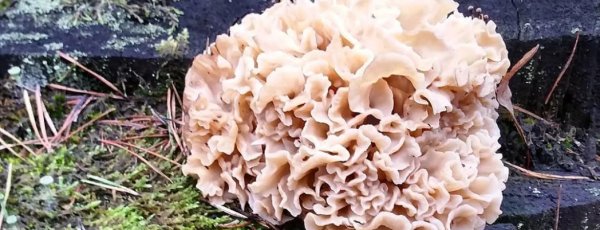
Mushroom cabbage is harvested in the wild in late summer and early fall. It is a parasite, it grows singly on the roots (or on stumps) of conifers, more often pine, destroying first the roots and then the trunk of the tree.
Similar species
Due to its characteristic appearance, curly sparassis can be confused with only two types:
Sparassis lamellar
The first of them, which is valued by mushroom pickers no less than its curly counterpart, and is just as rare, unfortunately. It differs in a more pronounced yellow color of the fruit body and, first of all, in that it settles on the wood of deciduous trees, most often on oak.
The second similar mushroom. Also known as the ram mushroom or the dancing mushroom. Also a rare species settling on deciduous wood. It is easy to distinguish it by the fact that there are many well-distinguishable legs and larger curls in the joint.

Interesting facts about sparassis curly
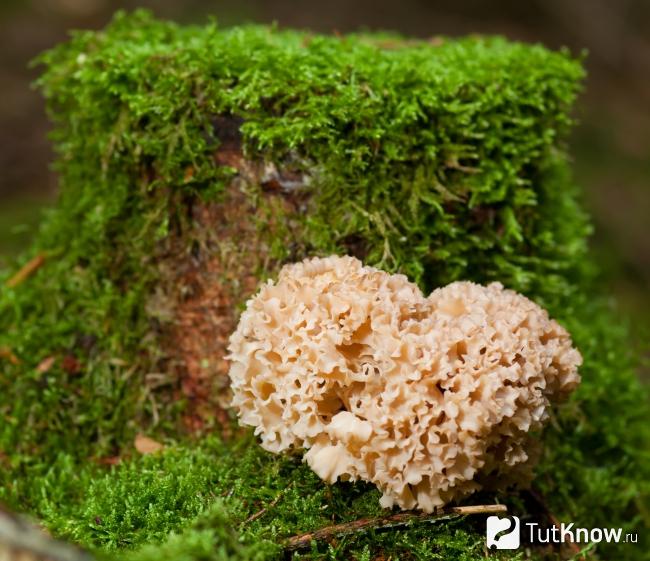
It seems that it is almost impossible to confuse curly sparassis with other mushrooms, it differs so much in appearance. However, after the rain, a mushroom with the botanical name Tremella takes on the shape of a hare cabbage, popular names are ice mushroom or shiver. Its body also consists of a mass of twigs-lobes, but the consistency is much softer. As soon as it becomes drier, the ice fungus inflorescences shrivel. It's okay if you mix it up, since this mushroom is also edible. In pickled form, it is very difficult to distinguish between different types of fruit bodies.
The formation of the fruiting body of mushroom cabbage occurs almost instantly. After the introduction of the spore into the wood within 10 days, the diameter of the "ball" reaches 60 cm and by weight 10 kg. But with artificial cultivation, the fruit body is formed within 2 months.
The Japanese and Americans have learned to grow sparassis in a specific color - white or pale beige. Plantation substrate is made by mixing coniferous sawdust and wheat bran, achieving high yields. 800 g of fruit chalk is removed from 3 kg of the prepared substrate.
In the cosmetic industry, mushroom cabbage extract is used as an ingredient in cosmetics to prevent age-related changes. The substance restores skin tone, maintains water and electrolyte balance and stimulates the production of natural collagen.
In medicine, the compound "sparassol" has been isolated from the pulp of curly sparassis, which has antibacterial and antitumor activity.
In the wild, the mushroom is rare; it is listed in the Red Book not only in Russia, but also abroad.
Watch a video about sparassis curly:
Sparassis curly recipes
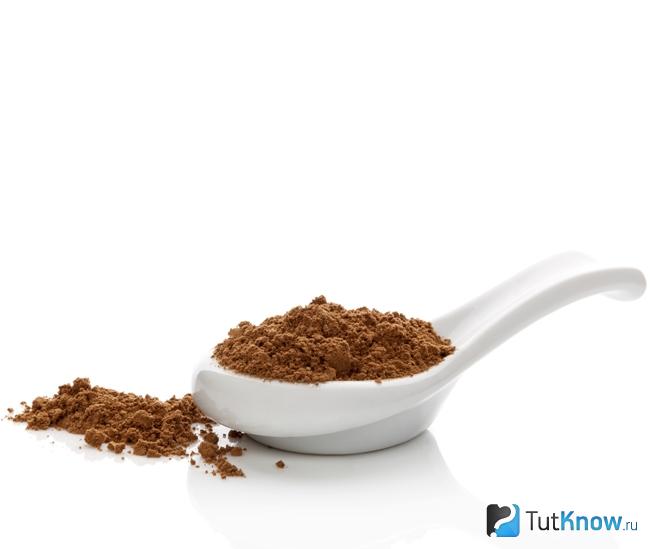
Curly sparassis is a rather expensive product. It is used boiled, fried, and even raw, added to sauces or gravies just before turning off. Interestingly, spices are practically not required during cooking, with the exception of salt. Mushroom cabbage has a delicate nutty taste, and the spices simply clog it.
Preparation for the preparation of a rare delicacy is carried out as follows: the fruit body is placed in cold water for 15-20 minutes to get rid of impurities. There is no other way to clean the folds, even if you disassemble the mushroom into inflorescences. After removing dust, dirt and insects, the inflorescence-blades are washed with running water.
Recipes from curly sparassis:
Cooking in a saucepan... Mushroom blades are lowered into a container with cold water, cut into small pieces, brought to a boil, salted and cooked for 20 minutes. Then they are thrown back on a sieve to glass the water. Vegetable oil is added before serving.
Cooking in a slow cooker... Mushrooms can be cooked in it in two ways. In the steam basket, for 30 minutes, add salt while laying. In a bowl, setting it to the "stewing" mode, putting the mushroom slices into a preheated saucepan. Cooking time - 16 minutes. There is no need to pour water, the pulp itself will give juice.
Frying mushroom cabbage... To fry mushroom inflorescences, the pan is well heated, a small amount of butter is melted, and mushroom pieces are fried, constantly stirring. You can switch off after 20 minutes. During cooking, the water evaporates, the contents of the pan are almost halved. The nutty flavor remains.
Drying curly sparassis... Dried in almost the same way as other mushrooms, but with some peculiarities. First, the inflorescence blades are separated from the fruiting body, then they are cut and only then they are spread on baking sheets. Drying in the oven takes 4-5 hours at a temperature of 60-70 ° C, the door must be kept ajar. In an electric dryer, the process takes 3 hours. If you plan to make mushroom powder after drying, then it is carried out in 2 stages.First, the inflorescences are washed entirely, soaking in cold water, then the moisture is allowed to drain, dried for 2-3 hours at a temperature of 30-40 ° C, and only then the temperature is raised or put into a dryer.
Mushroom powder... Dry mushrooms are ground to flour in a blender, adding a little salt. From spices, cinnamon or cloves are used, just a little, so as not to interrupt the natural delicate taste. Mushroom powder is stored in sealed glass jars without air access.
Mushroom Powder Sauce... Fry a large onion in butter, put 2 tablespoons of flour in a pan and stir vigorously so that no lumps form. Pour in a little water, so that a puree-like mass is obtained, and add mushroom cabbage powder. Boil for 2 minutes, add sour cream and finely chopped parsley, add salt. Cook for another 2 minutes, turn it off and let it brew for 5 minutes before serving. The sauce goes well with pasta and any kind of porridge.
Pepper stuffed with curly sparassis... Pepper is cleaned of partitions and seeds, cut into 2 halves. In the future, they are used as bowls for stuffing. Peel the onion, fry in butter, add finely chopped chicken fillet to the pan, fry for 10 minutes, and then finely chop pieces of sparassis and bring to readiness, slightly salting. Cheese is grated separately. Fill the halves of the pepper with the mushroom mixture, sprinkle with cheese, spread on a baking sheet. It is placed in an oven preheated to 170-180 ° C. Turn off when the cheese is completely melted. You can use any greens for decoration.
Fried or boiled curly sparassis is suitable as a side dish for seafood, the taste goes well with shrimp, the dish is served as an appetizer, along with cheese and almonds. Boiled sparassis is used as a filling for dumplings, pancakes, spread on pizza. The powder is added to sauces, sprinkled with ready-made soups, hot dishes, and tonic drinks for bodybuilders are made.

